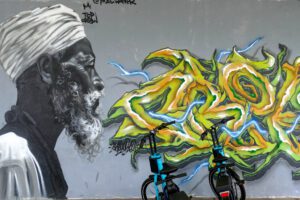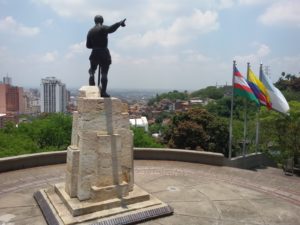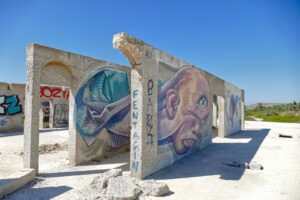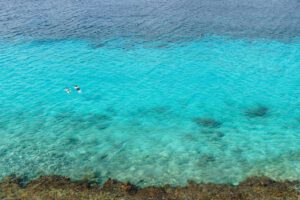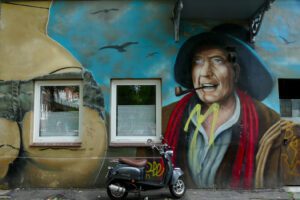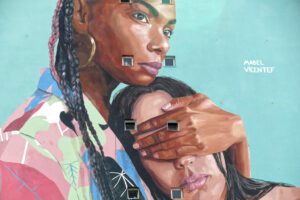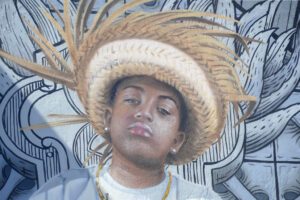Vilnius, the vibrant capital of Lithuania, is rapidly becoming a dynamic center of street art, delighting locals and visitors. From striking larger-than-life murals to subtle stencil drawings in hidden alleys, the city’s urban art scene reflects a diverse mix of civic engagement and creative freedom. Mind you, these values hold particular significance in a country, finally independent after centuries of foreign hegemony and cultural oppression.

In this post, I’ll take you to remarkable places where the best street art in Vilnius thrives. I’ll explore the stories behind some of the city’s most outstanding works and show you how urban art shapes Vilnius’ identity as a center of creativity and innovation.
Street Art in Vilnius
Obviously, you won’t find much street art in the very heart of Vilnius’ historic center. But there are two streets you absolutely shouldn’t miss, as they are lovingly decorated with small sculptures.
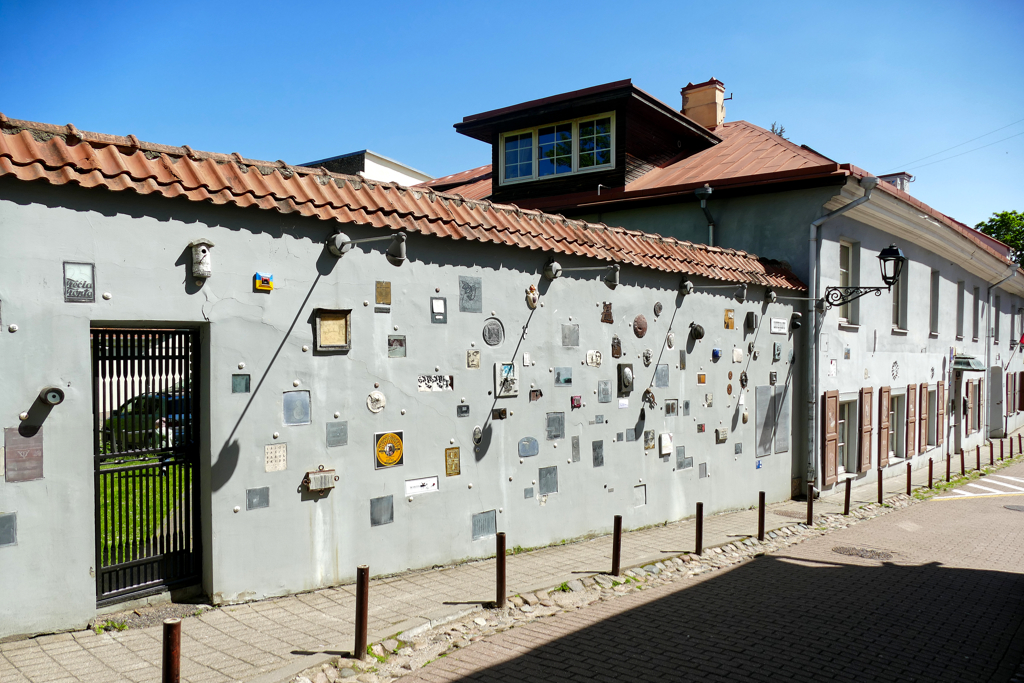
Well, in one case, strictly speaking, they’re ‘just’ teapots. But who would have thought that teapots could be true works of art?
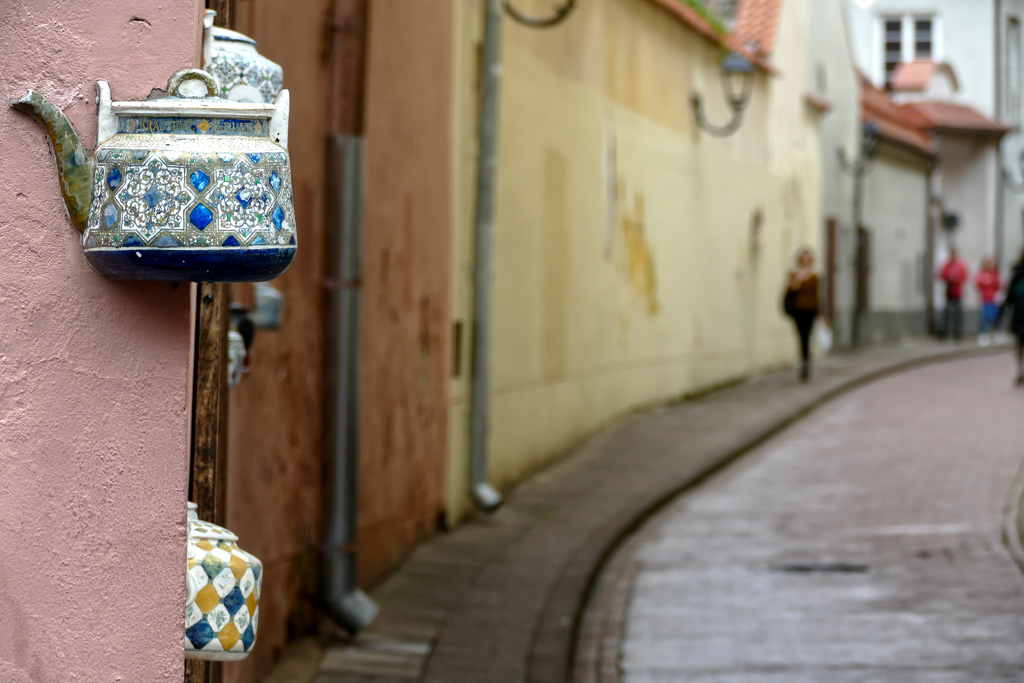
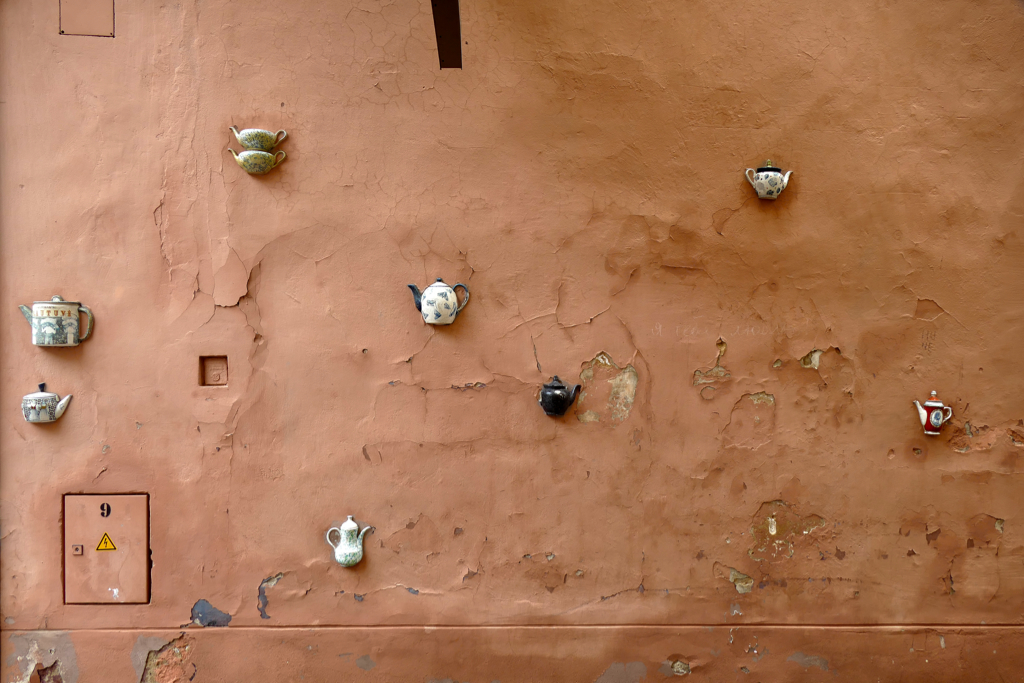
So while the historic part of the city has some cute decorations to discover, the murals are outsourced from the baroque center.
Over recent years, street art in Vilnius has flourished thanks to a growing community of talented artists who use the city’s walls to tell stories that resonate deeply with urban art aficionados. These works range from colorful, large-scale murals that celebrate local heritage and identity to provocative pieces that address global issues. Street art festivals and initiatives have further boosted this cultural renaissance, encouraging collaboration and dialogue between artists, residents, and visitors.
An indescribable treasure trove of fantastic street art from Lithuania and abroad can be found southwest of the city center in the Naujamiestis district. Here, on a former factory site, you’ll find a unique open-air gallery. More than 50 street artists have left their creative mark here. There are sculptures and light installations, but above all, the most incredible murals. And the best part is that the gallery is a dynamic and continuously growing project, constantly expanding with new artworks and installations. So it’s worth stopping by every time you visit Vilnius to see what fantastic art has been added.
Atvira Meno Galerija – Vilnius’ Open Gallery
The Atvira Meno Galerija emerged as a vigorous cultural project in Vilnius, transforming a former industrial space into a thriving hub for contemporary art. Its origins are deeply tied to the history of the site, which was once home to the Elfa factory, a major manufacturing plant during the Soviet era.

The Elfa factory was established in the mid-20th century and specialized in producing electronic devices and radio equipment. It was one of the key industrial facilities in Vilnius, employing a significant portion of the local workforce. The factory’s large, utilitarian buildings and spacious outdoor areas reflected the industrial architectural style of that period.
However, following the collapse of the Soviet Union and Lithuania’s independence in the early 1990s, many factories, including Elfa, faced decline and eventual closure. The industrial site was left abandoned for years.
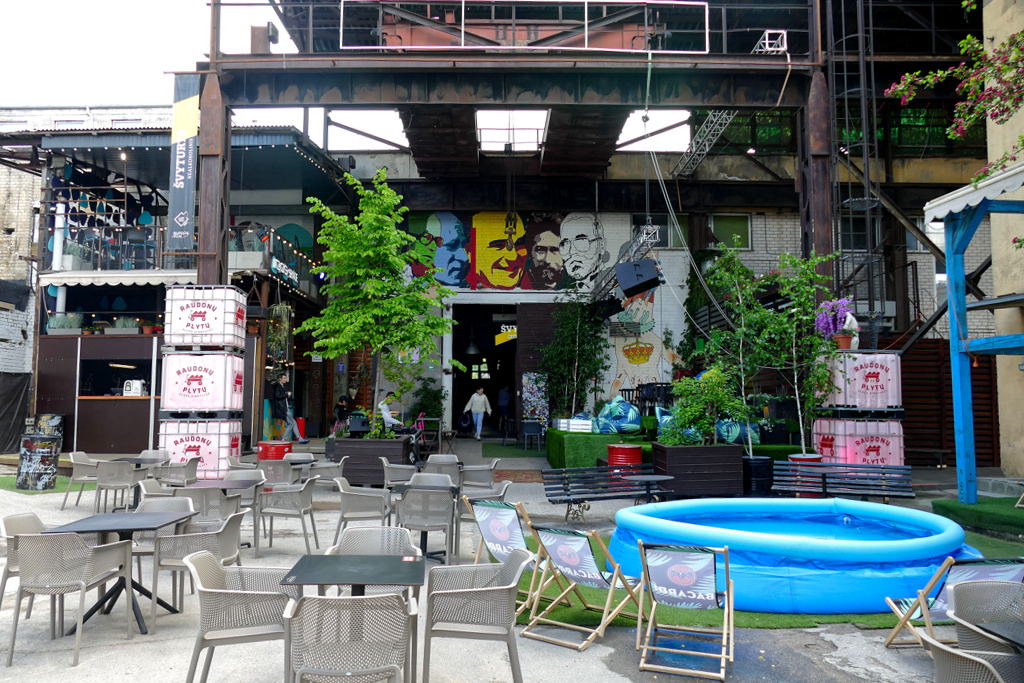
In the early 2010s, however, a group of artists, cultural activists, and community organizers saw an opportunity to reclaim and repurpose the neglected factory grounds. They envisioned an open-air art gallery that would not only preserve the industrial heritage of the site but also create a dynamic space for creative expression.
Since its establishment, the Atvira Meno Galerija has grown into an innovative cultural landmark. The large factory walls and outdoor areas became canvases for murals, light installations, sculptures, and other contemporary artworks by both Lithuanian and international artists.
Below you’ll find the best murals currently on display. For convenience, I’ve listed the artists in the order of my tour, starting from the main entrance and proceeding counterclockwise.
Morfai
It actually begins on the outside of the eastern wall, where Morfai painted his impressive work The Epic of the Crossing.
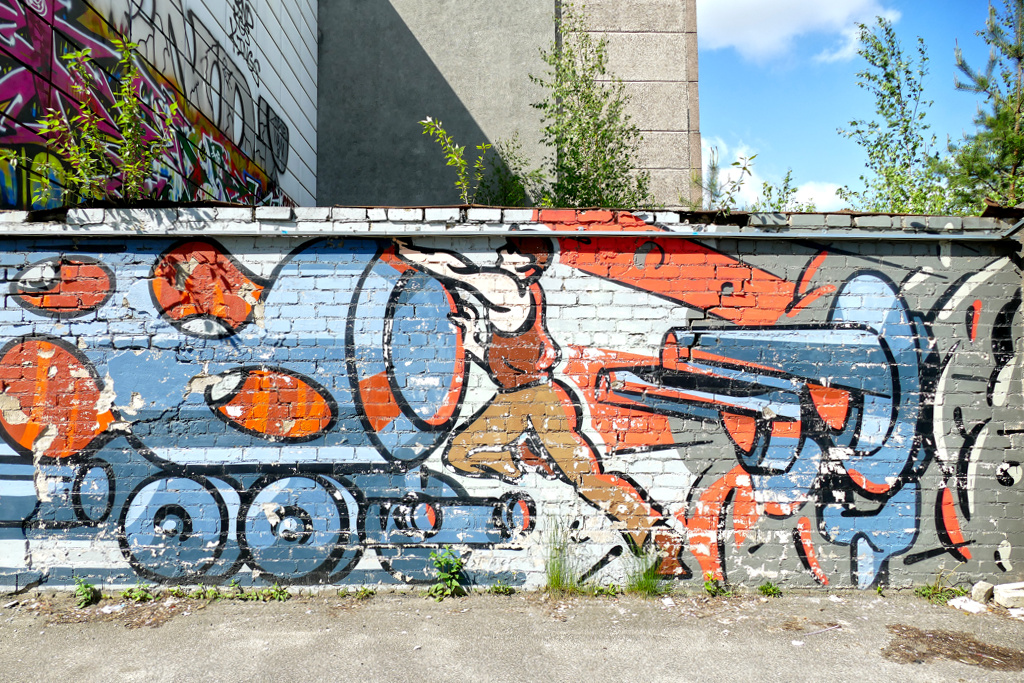
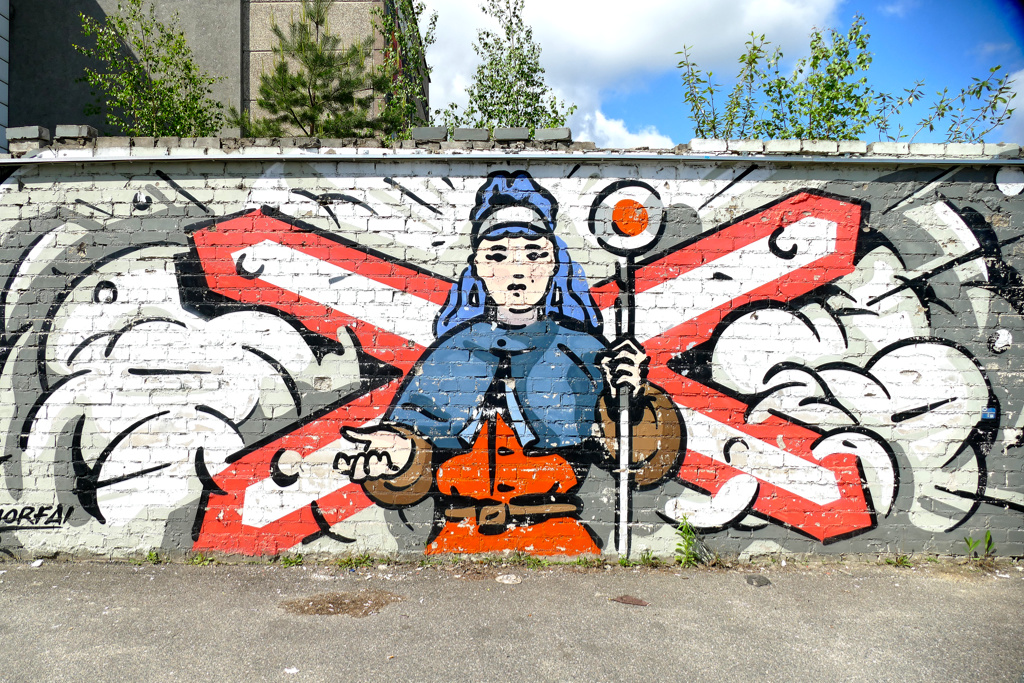
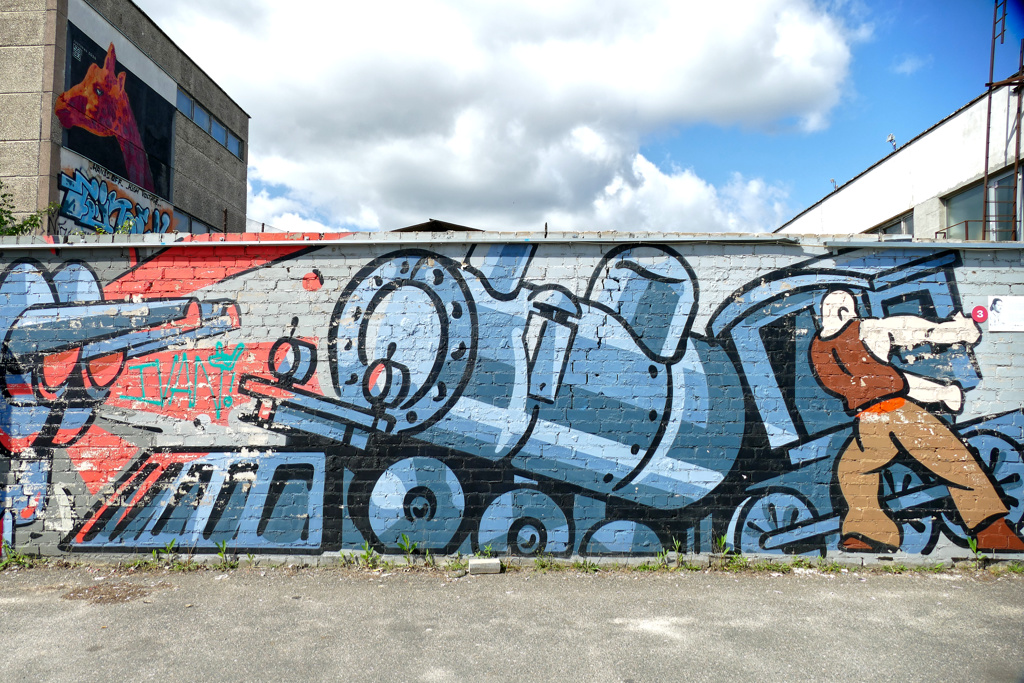
Morfai, born Timotiejus Norvila in 1985, is one of Lithuania’s leading street artists. He is known for enriching urban spaces with thought-provoking works. The Kaunas-based artist combines classical art influences with contemporary techniques and social critique.
His breakthrough work, The Sower, appeared illegally behind the historic Sower statue in Kaunas in 2008. The work, from whose hand stars flow, was initially removed but later went viral on the internet.
And years later, it became Lithuania’s first officially legalized piece of street art!
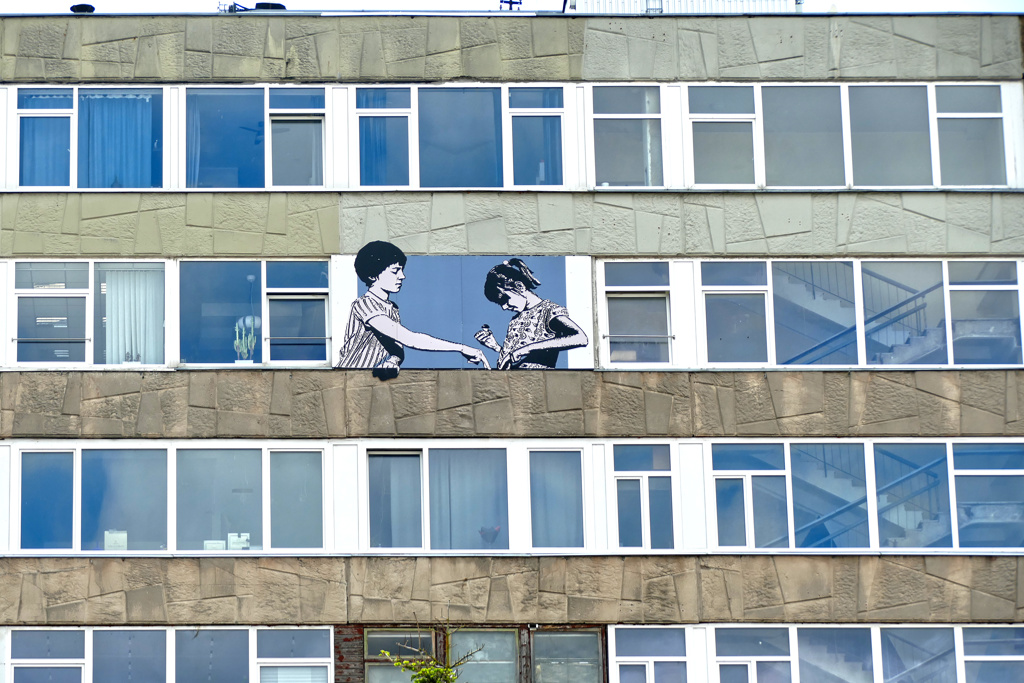
Today, Morfai’s murals can be found throughout Kaunas and other Lithuanian cities. They combine realism with symbolism and draw on interwar iconography, folk symbols, and myths, transforming often overlooked corners into monumental works.
Morfai has contributed significantly to redefining street art in Lithuania, bringing it from the margins to the mainstream with intelligence, grace, and a keen sense of position.
In addition to murals, Morfai works in various other media.
For his work Anvils in the Style of Interwar Architecture, he received the first prize at ART Vilnius in 2020.
K ART 7
Linas Kaziulionis aka K ART 7 hails from Vilnius and combines academic painting with graffiti. A graduate of the Vilnius Academy of Arts, he began as a clandestine graffiti writer and developed into a respected muralist. He is primarily celebrated for his unique, idiosyncratic interpretation of classical paintings in a contemporary street art context. His works masterfully combine academic technique with the vitality of the street.
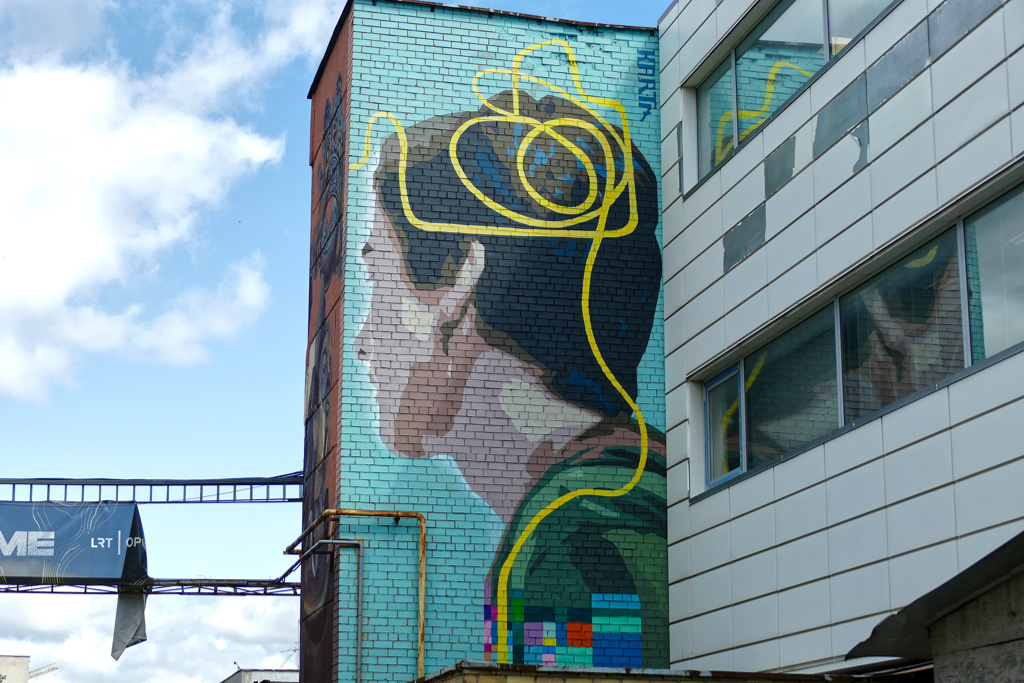
K ART 7 has created murals and participated in festivals in Sweden, Denmark, Kosovo, and Thailand, to name a few.
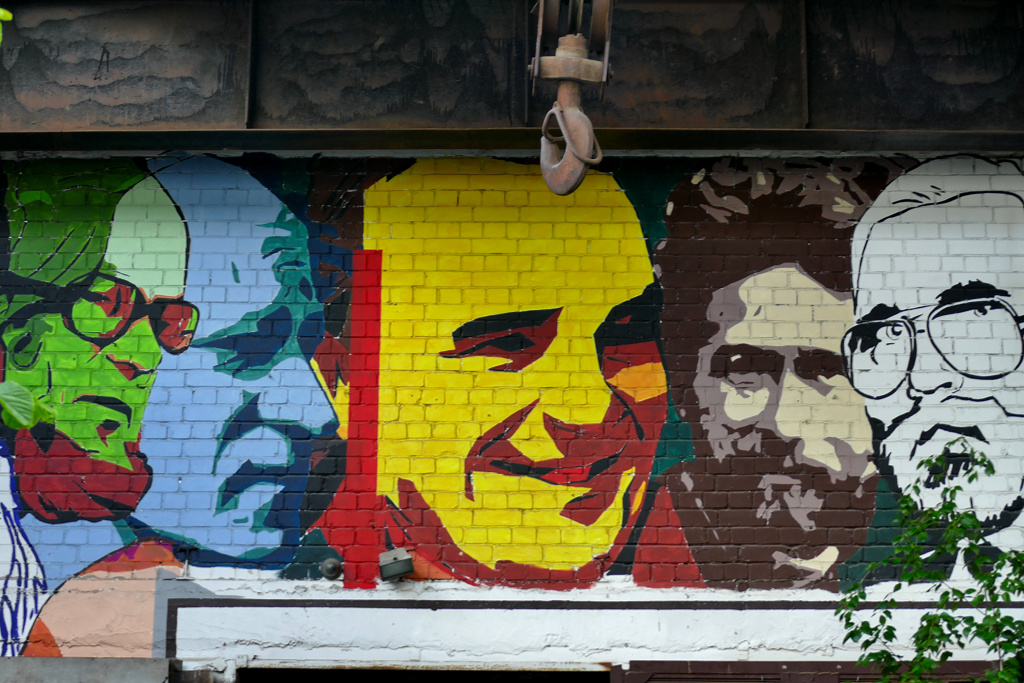
In 2022, he was awarded the Young Painter Prize, which led to solo exhibitions in Vilnius and Paris, a residency in Iceland, and commissions for the Lithuanian National Museum of Art.
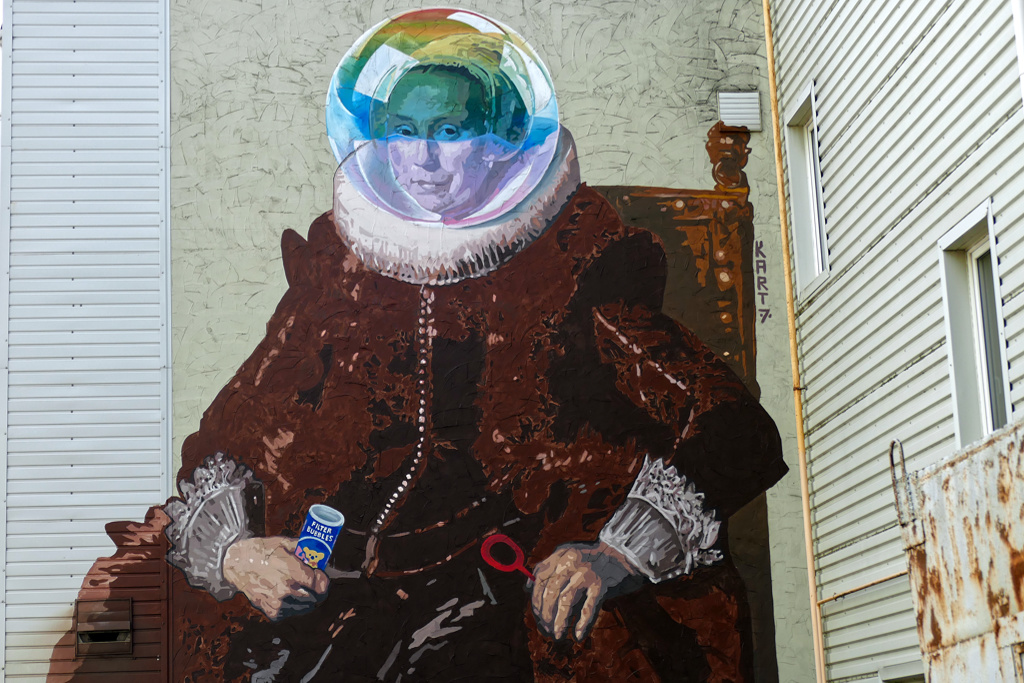
K ART 7 has left behind several works on the grounds of the Atvira Meno Galerija. The most famous is certainly the Mother of the Festival, for which he drew on Whistler’s famous portrait of the artist’s mother.
Telmo Miel
Telmo Pieper and Miel Krutzmann form the Dutch street art duo Telmo Miel. Both graduated from the Willem de Kooning Academy in Rotterdam.
They have made an international name for themselves with their surreal, richly detailed murals. They combine realism with dreamlike compositions and cross the boundaries between fantasy and reality.
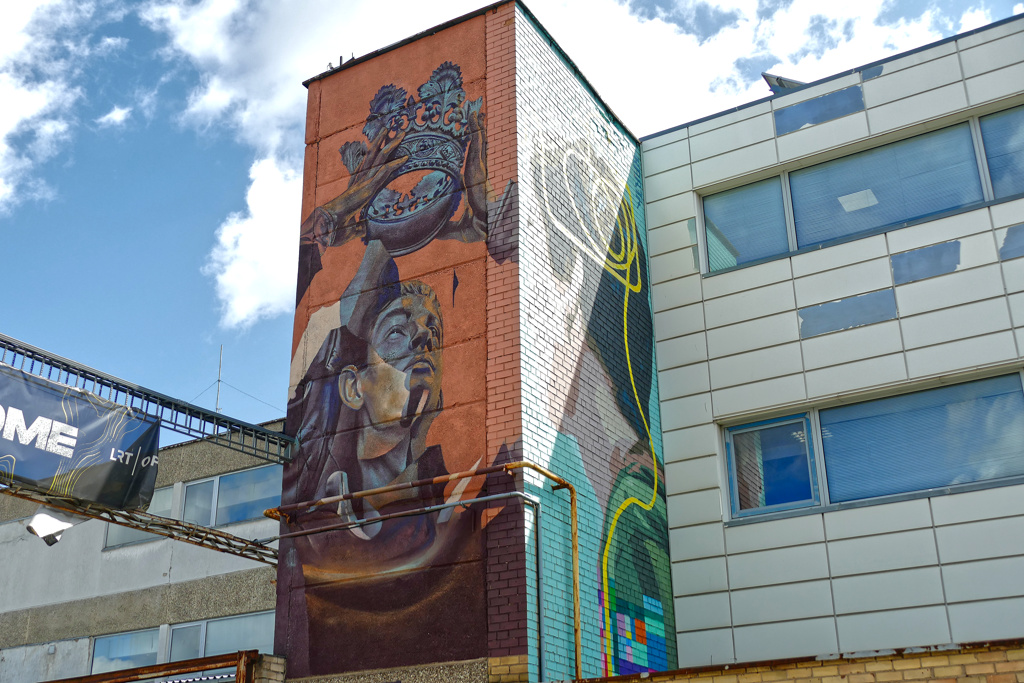
The duo has been working together since 2007 and has officially operated as Telmo Miel since 2012. They create large-scale murals that often depict fragmented figures, playful optical illusions, and narrative depth. Their collaborative process is seamless on many levels, with each artist working on the entire surface.
Their murals often address themes of duality, such as childhood and adulthood, growth and decay, reality and fantasy. Human beings and animals merge, transform, or dissolve into surreal landscapes. The viewer often has to look really closely.
Telmo Miel has created numerous works in Europe, the Americas, Asia, and Oceania. In addition to their urban art, they also paint on canvas.
BLO
Claude Blo Ricci aka BLO is a French muralist who emerged from Lyon’s traditional graffiti scene. Initially, he embraced the raw spontaneity of spray, ink, and traditional graffiti. Over time, however, BLO’s visual language evolved into a sophisticated, figurative abstraction, heavily influenced by classical art, surrealism, and even religious iconography. He combines rapid graffiti techniques with nuanced compositions. In his depictions of the Virgin Mary and the Memento Mori, he often uses disjointed female forms.
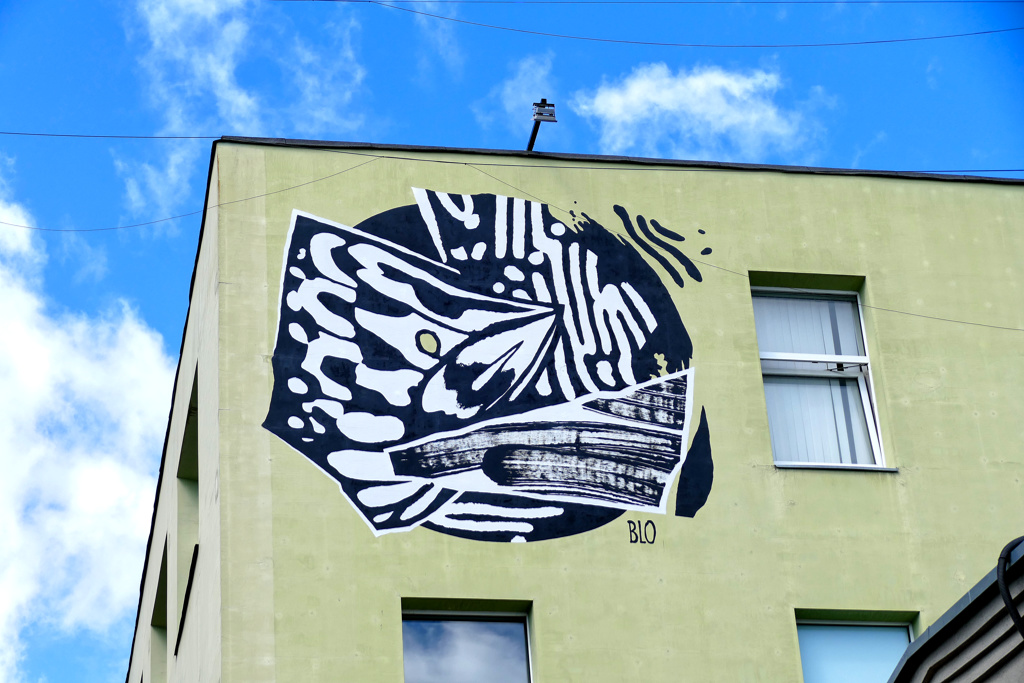
In recent years, BLO has frequently used his real name to emphasize his artistic evolution.
Eglė Žvirblytė
Eglė Žvirblytė is a multidisciplinary artist born in Vilnius and living in London. Her vibrant, surreal murals and installations explore identity, spirituality, body positivity, and feminism with playful energy.
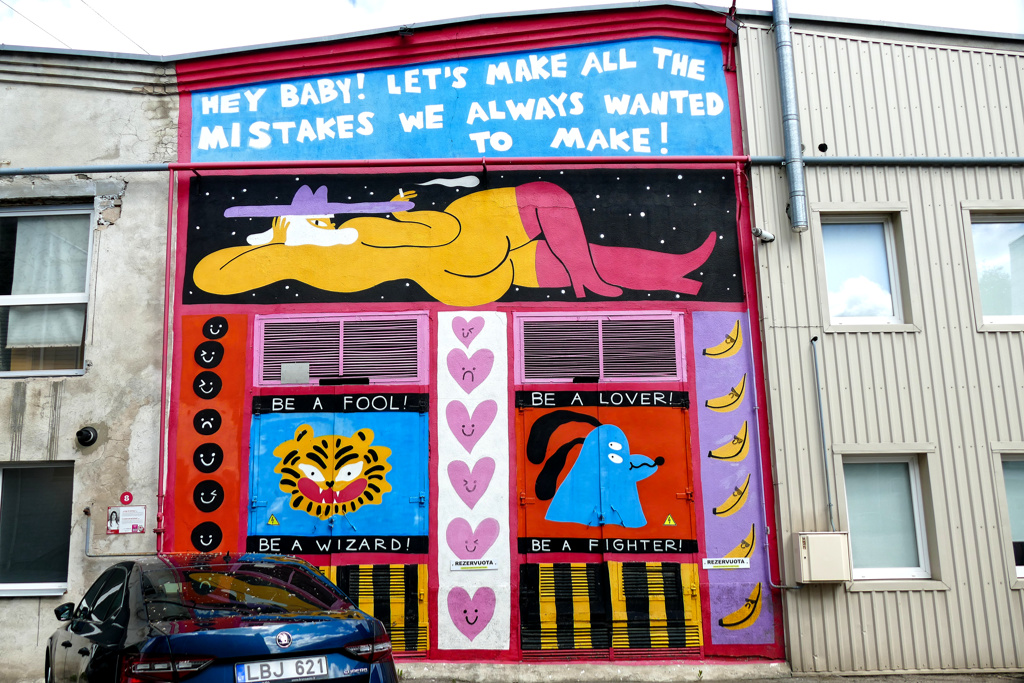
Her quirky style is characterized by bold colors, energetic compositions, lively storytelling, and plenty of eccentric humor. She brings a fresh, optimistic energy to urban spaces.
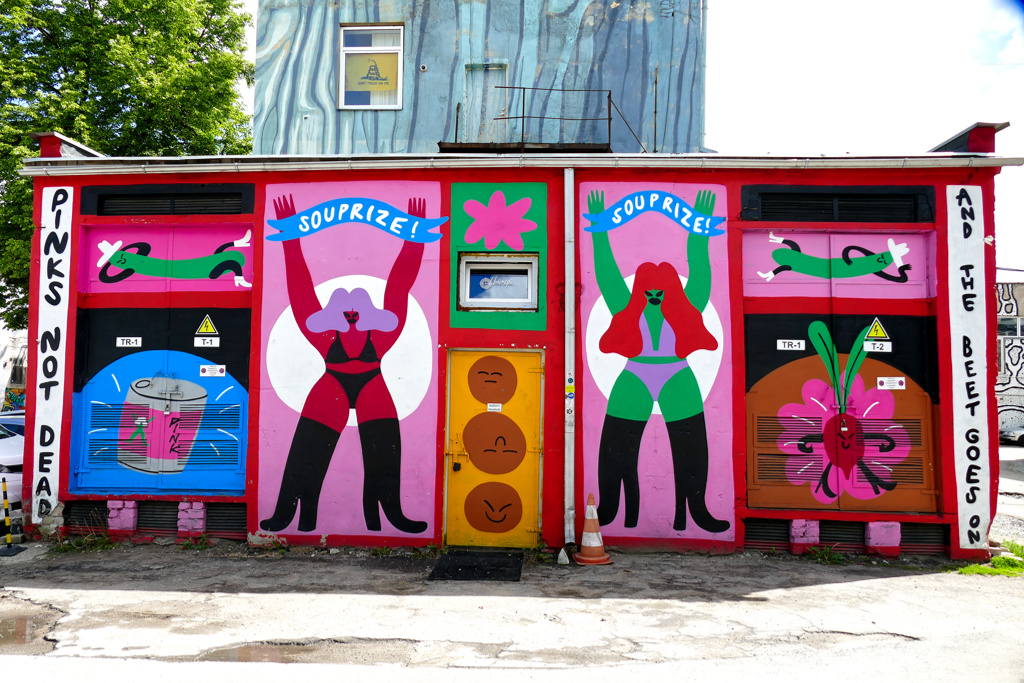
Žvirblytė holds degrees in film studies, interior design, and spatial design. Her fields of work include illustration, stage and product design, public art, and inflatable installations. She has created murals and installations in many places around the world, including Bali, Barcelona, Melbourne, New York, and Tokyo. Major brands such as Adidas, Apple, Google, and Nike have commissioned her to embellish their products.
Marija Tiurina
Marija Tiurina was born in Lithuania, but lives now in the Netherlands. She is a multidisciplinary artist whose vivid, surreal murals and illustrations weave whimsical narratives around topics such as self‑care, human connection, and the linkage to nature.
Trained in multimedia design in London, she began her creative journey as a concept artist and illustrator for many major international brands.
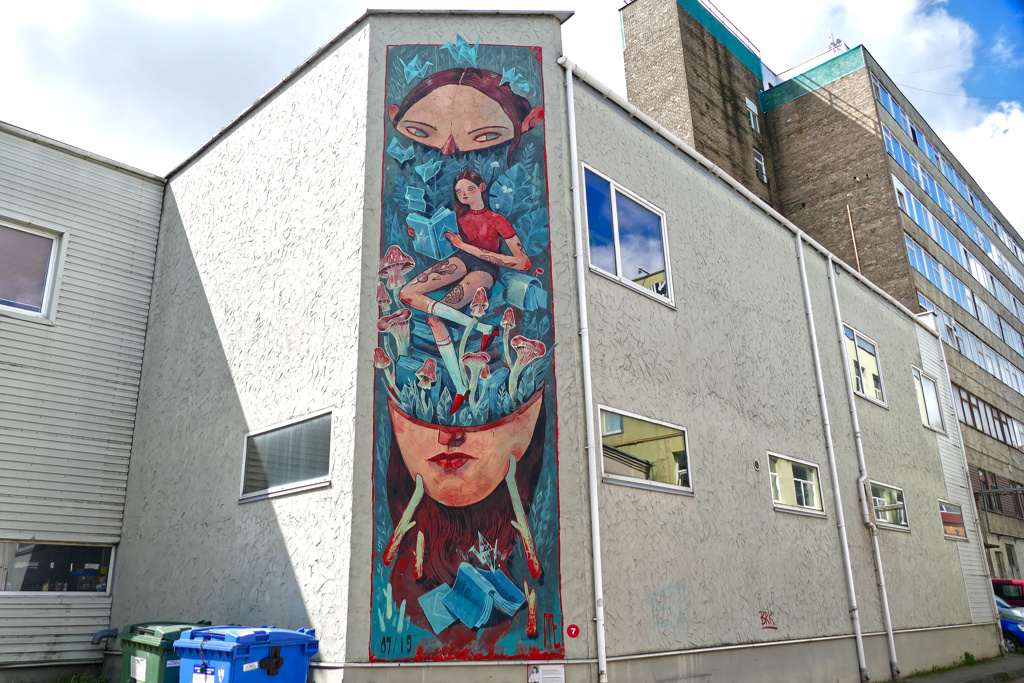
In addition, Marija has embraced muralism as an extension of her creative practice. In this field, she can bring her intricate watercolor and digital-style drawings to large-scale public artworks. Her images, full of warm, surreal imagery, transform walls into happy places.
Apart from creating murals, Marija continues her impressive career by illustrating children’s books, puzzles, toys, and much more.
Whether transforming walls, pages, or everyday objects, Marija Tiurina blends imagination, craft, and empathy into her art.
I introduce another absolutely wonderful mural by Marija Tiurina in my post Best Street Art in LONDON – Part II: Shoreditch.
Ernest Zacharevic
And now to Ernest Zacharevic. I’d almost say it was Zacharevic’s murals in the Malaysian city of George Town that sparked my passion for street art.
Zacharevic was born in Lithuania in 1986. Today, he is a globally celebrated contemporary artist who bridges fine art and street art with poetic sensibility. Educated at Vilnius’s National School of Arts as well as Middlesex University’s School of Fine Arts in London, he fuses oil painting, stencil, spray, installation, and sculpture techniques to create immersive pieces that literally interact with the urban landscape.
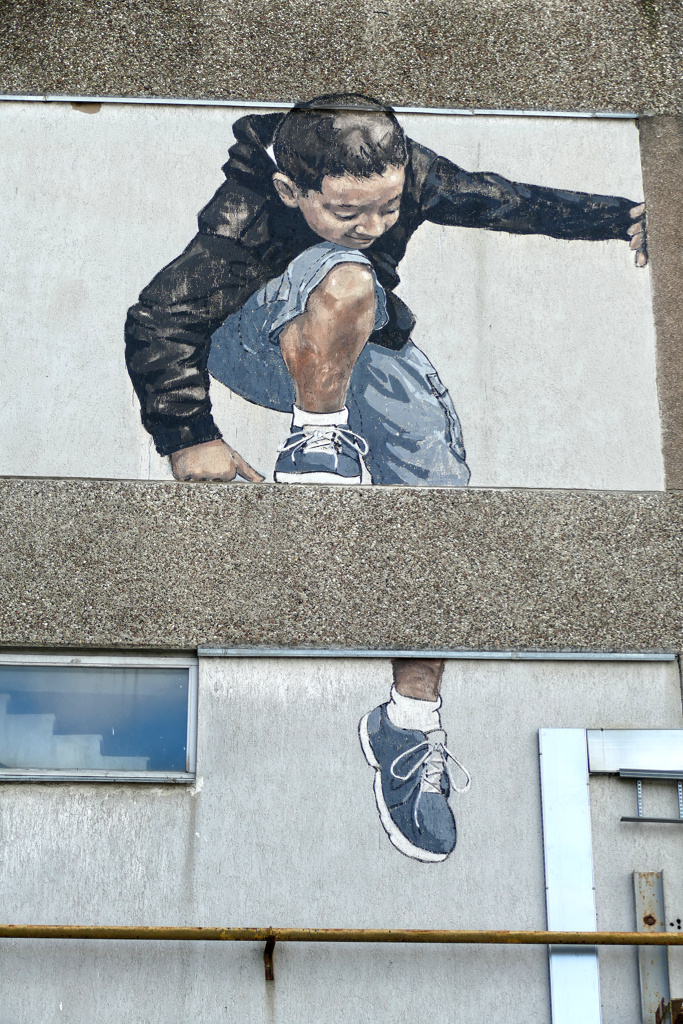
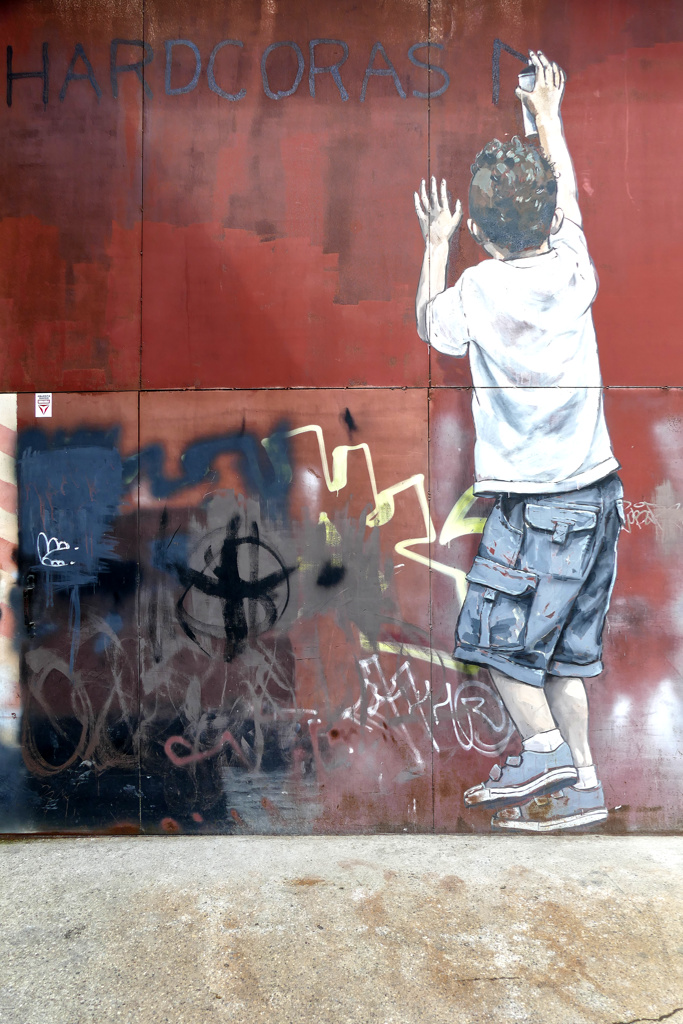
He had his major breakthrough during the George Town Cultural Festival on the Malaysian peninsula of Penang in 2012. There, he debuted his signature interactive murals. These works, blending painted figures with objects and local narratives, resonated worldwide and became iconic photo spots.
Since then, Zacharevic’s career includes a series of globally acclaimed projects. However, he splits his time between Malaysia and global urban art hotspots, working on public art, gallery shows, and environmental activism through art.
Side Note
Ernest Zacharevic recently stirred up the street art scene when he took legal action to protect his artistic work.
In January 2025, he sued the airline AirAsia for the unauthorized use of his mural Children on a Bicycle on one of its aircraft. Zacharevic originally created the mural in 2012. He first discovered the motif in an AirAsia advertising campaign in 2013 and demanded that the airline discontinue it. Despite this request, the image reappeared in an aircraft livery. After failed negotiations, Zacharevic filed a lawsuit to enforce his copyrights and draw attention to the importance of intellectual property for artists.
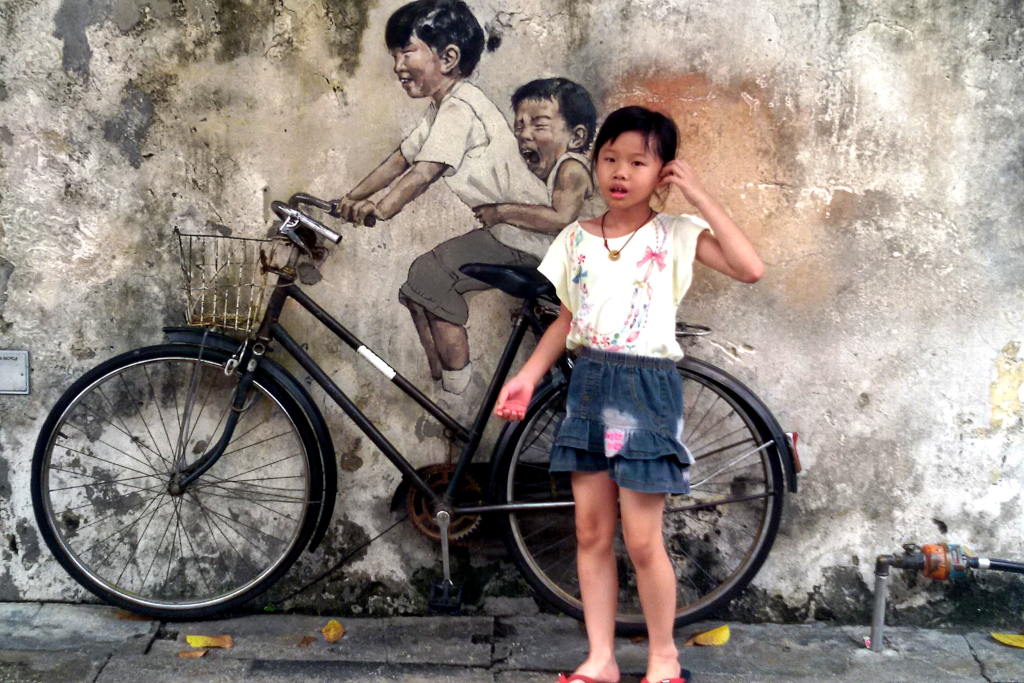
Zacharevic emphasizes that the commercial exploitation of street art without the consent of the artists is a recurring problem. He sees it as his responsibility to advocate for artists’ rights and highlight the need for fair compensation.
If you’re looking for tips on how to avoid copyright infringement on your blog or social media, check out my post How to Avoid Copyright Infringement: Unexpected Traps.
IUSTAS
Justas Pranevičius aka IUSTAS is a Lithuanian-born visual artist whose work combines portraiture, illustration, and studio art. Working primarily in oil, acrylic, and alla prima techniques, he has gained a reputation for his intimate, expressive depictions of human faces.
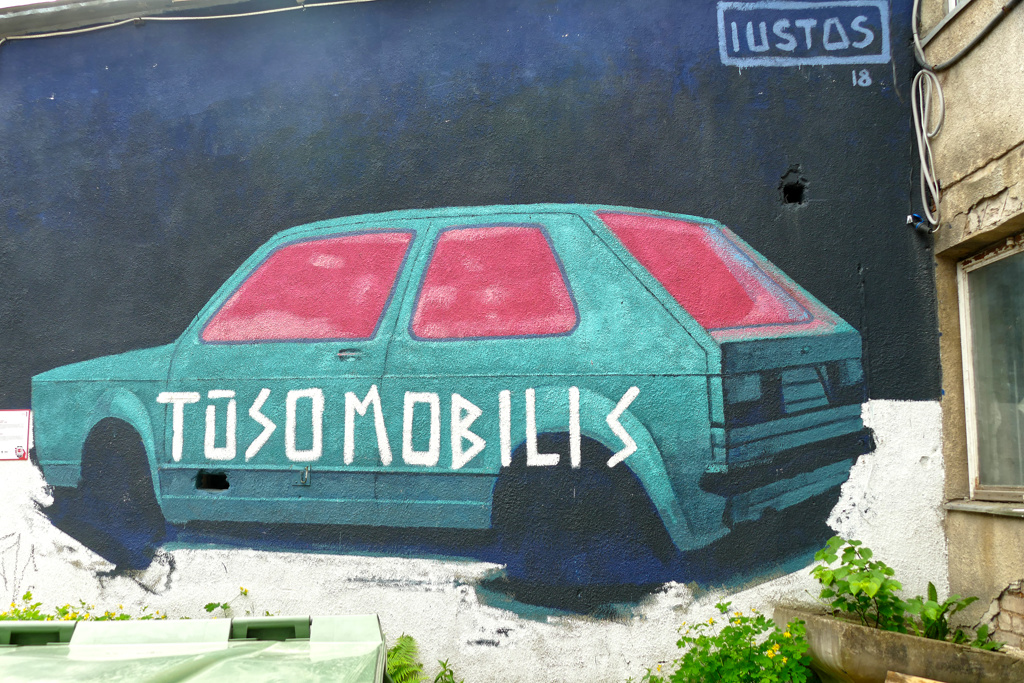
Although Iustas is not a street artist in the strictest sense, his works occasionally find their way into public spaces through pop-up exhibitions and collaborations. His portraits have been published in the Lithuanian art press and online creative communities and are appreciated for their painterly immediacy and keen observation.
Dirty Elmo
Erik Lindstrom aka Dirty Elmo is a Swedish street artist who deserves an award for that moniker alone! He is known for his vibrant, symbolic murals that span cities across Europe, particularly in Sweden and Lithuania. His works are characterized by bold color palettes, anthropomorphic figures, and a strong focus on the harmony of each mural with its architectural surroundings.
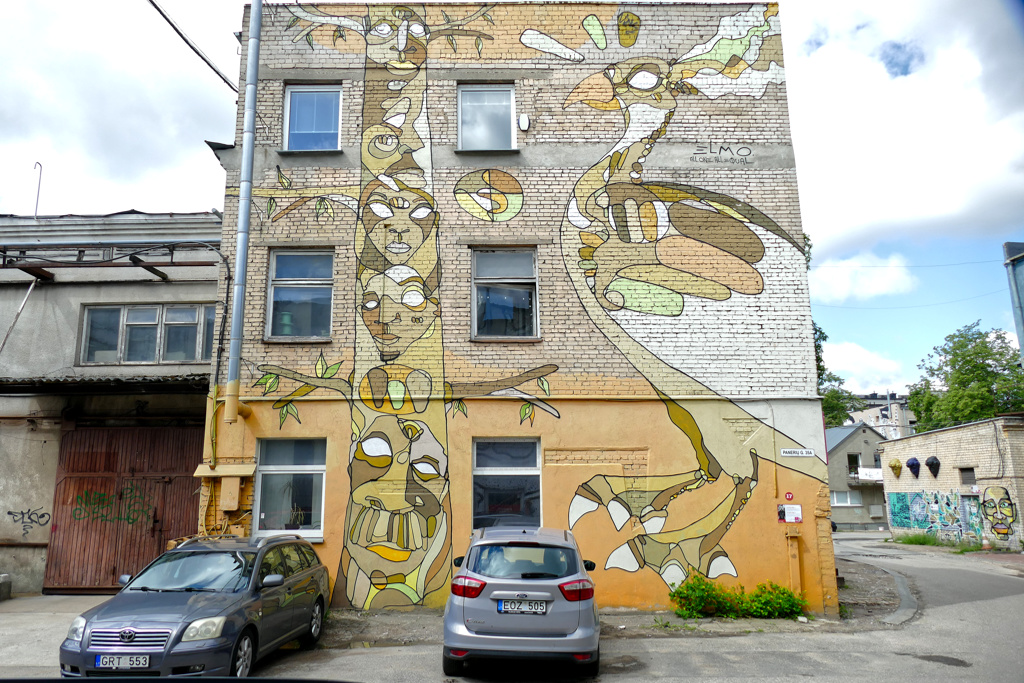
A traveling artist, Dirty Elmo creates murals in various urban settings, blending his symbolic, often surreal style with the local architecture. His works are appreciated not only for their aesthetic appeal but also for their thoughtful concepts. Fans and locals alike praise the warmth and positivity his works bring to public spaces, finding them visually appealing and spiritually uplifting.
Povilas Kupčinskas
Povilas Kupčinskas is a Lithuanian street artist whose work is defined by its dramatic and unconventional use of fire, soot, and ochre. Therefore, he’s also known by his striking nickname Povas on Fire.
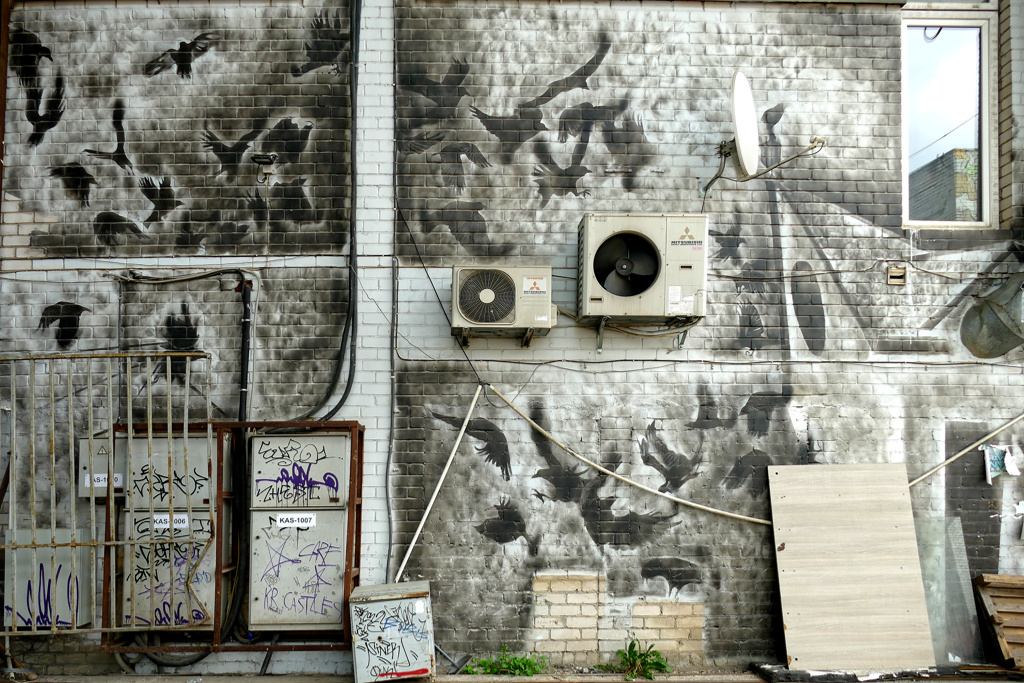
After beginning his journey with graffiti and spray paint during his studies at Kaunas, he developed a fumage technique that involves burning soot onto walls to create ethereal, monochromatic murals. He began experimenting by cutting stencils in OSB panels and burning soot onto abandoned buildings, eventually mastering controlled shading with heat and masking to shape his distinctive aesthetic.

Kupčinskas describes his creative process as a form of cleansing, hence, a kind of burning down, all negativity to reach a spiritual underlayer.
Obviously, Povilas Kupčinskas stands out in today’s street art scene through his unique fusion of raw elemental fire, historical storytelling, and profound visual symbolism.
Sokar Uno
Sokar Uno was born in the city of Gotha in the German federal state of Thuringia. He is now based in Berlin, where he merges graffiti, painting, and illustration into hauntingly beautiful murals and canvases. He began painting graffiti in 1999 and has since developed a highly recognizable style marked by desolate human figures.

Drawing inspiration from his mother’s portrait work and 1990s comic heroes, Sokar Uno creates emotionally charged and slightly morbid pieces. These works are executed in spray, acrylic, brushes, and rollers, producing textured, tactile optics.
Today, Sokar Uno’s work can be found all across Europe in cities like Berlin, London, and Bristol.
Perkup
Paul Riedmüller, alias Perkup, is a Vienna-based artist whose work encompasses graffiti, graphic design, animation, and large-scale murals. He has a distinctive, hyperrealistic style and combines digital collages, photorealistic elements, abstract patterns, and pop culture references to create his visual narratives.
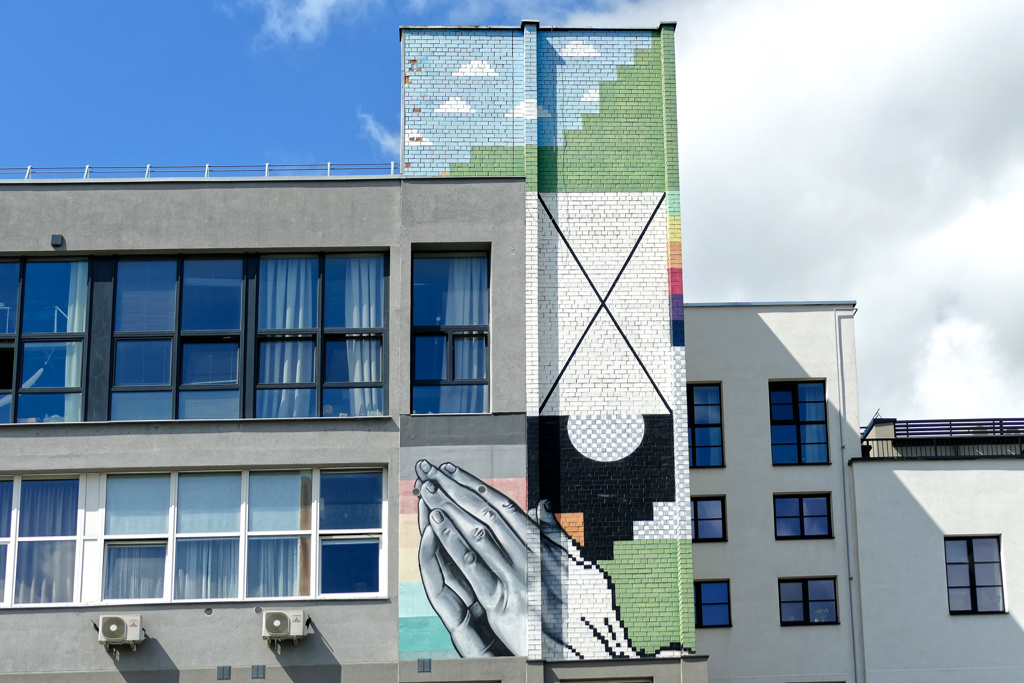
Perkup’s art is visually rich, infinitely layered, and contextually relevant, making him a compelling voice in the evolving European street art scene.
He is active in Vienna’s urban art scene. His murals around the city are often documented in art directories.
I’ve already introduced Perkup in my post Best Street Art in VIENNA.
David Leitner
Another Austrian artist in this overview is David Leitner. Originally from the city of Graz, he is now living in Vienna.
In 2020, he graduated from the University of Applied Arts in Vienna.
His career sparked with the project Würmlas Wände, hence, the walls of Würmla. In this ambitious project, he created a series of 13 murals covering 700 square meters of silos and facades in the Austrian village of Würmla.
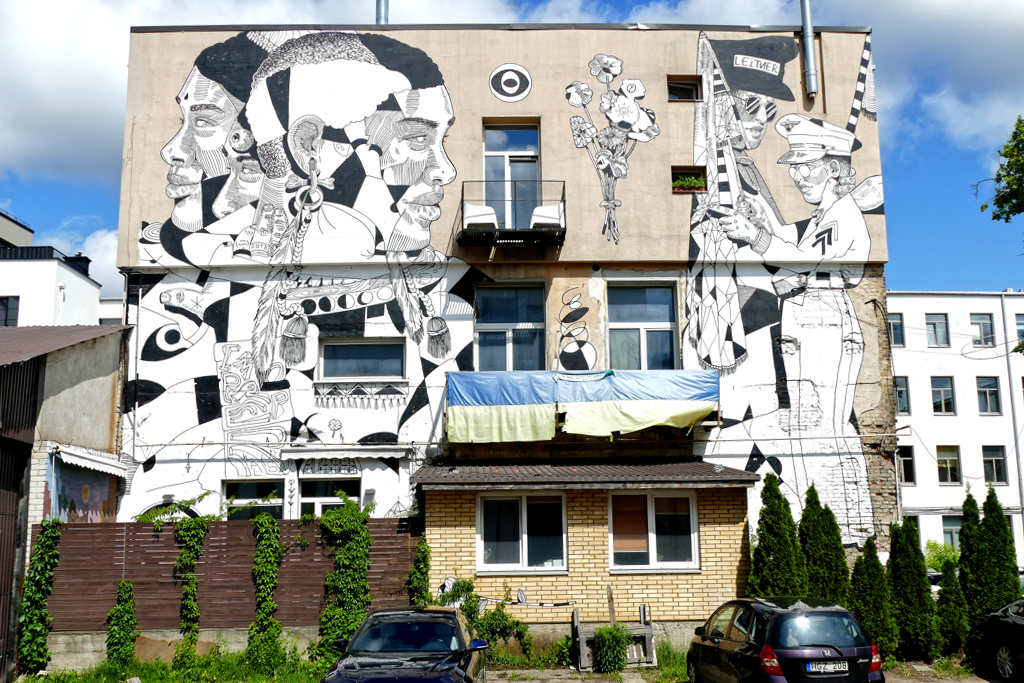
Leitner’s signature style often leans toward black-and-white compositions with some accents here and there. He draws inspiration from figurative traditions, photographs, but also AI-generated motifs, which he then weaves into surreal, emotionally evocative compositions.
David Leitner works globally, so that his murals are found in various European and Asian countries as well as in the USA. He is alternating between large-scale murals, commercial collaborations, and gallery exhibitions.
Agnė Juršytė
Agnė Juršytė was born in Vilnius in 1979. She graduated in graphic arts from the Vilnius Academy of Arts in 2005, and has been a member of the Lithuanian Artists’ Association since 2008.
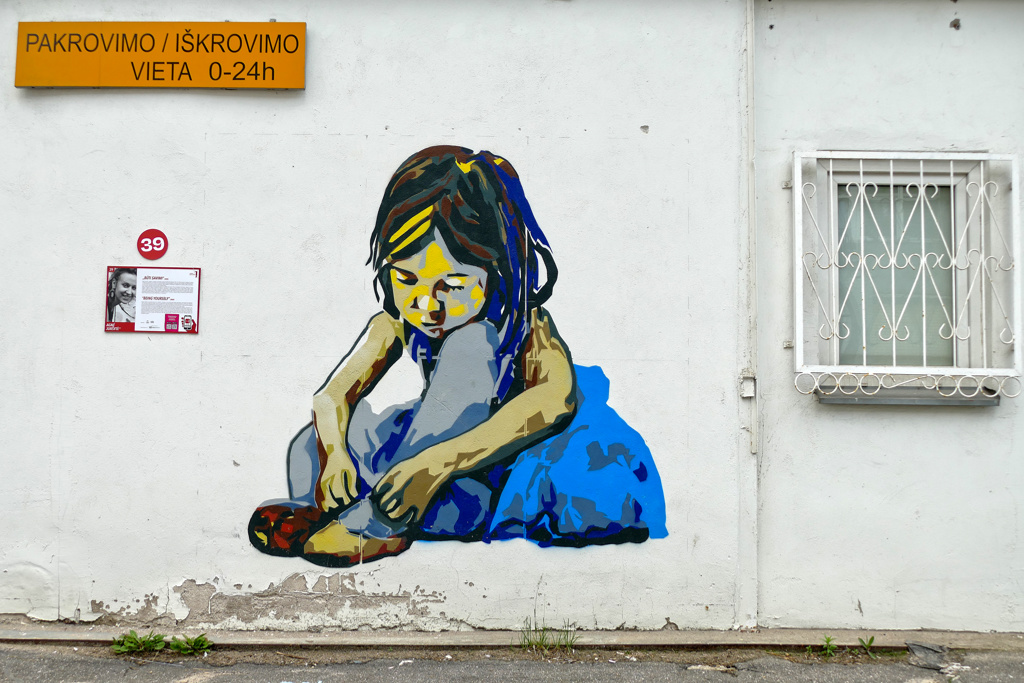
Her early career focused on graphic techniques, but she gradually embraced painting large-format works characterized by bold, industrial-inspired color palettes.
Agnė has shown her work in various solo exhibitions across Lithuania and beyond. She also participated in major international events in Andorra, Paris and, Tokyo.
Eglė Narbutaitė
Eglė Narbutaitė was born in 1988 and studied media art and performance art at Kingston University in London. She works as a visual artist, illustrator, scenographer, performer, and street artist. Her works are based on sharp observation and social criticism with a playful, often ironic expression.
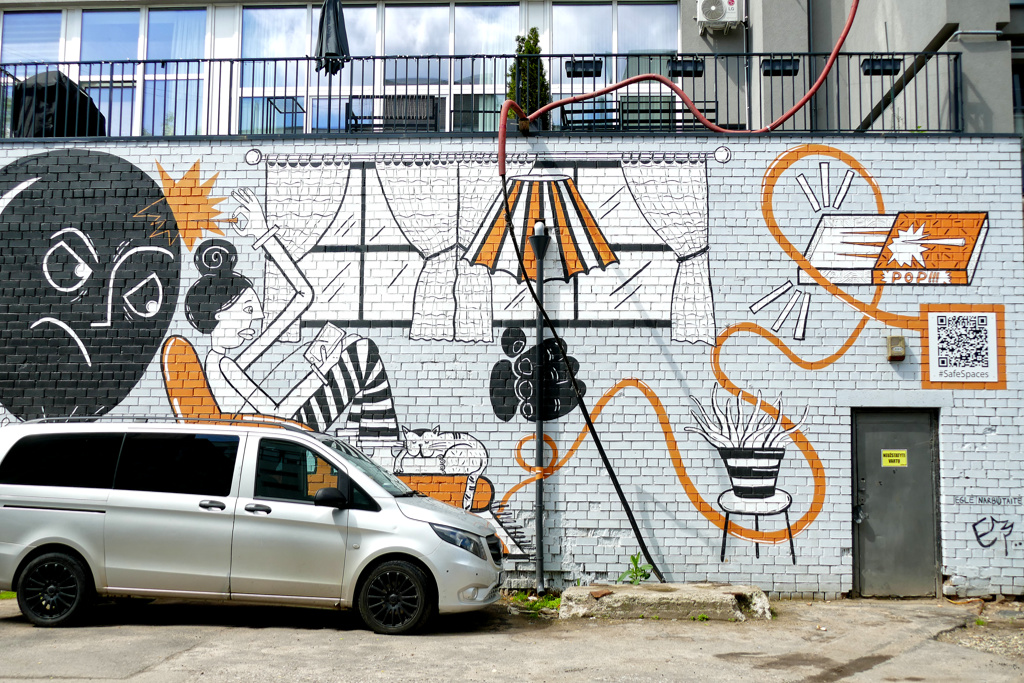
Her style is characterized by minimalist drawings, handwritten texts, and a narrative flow that reflects everyday absurdities, emotional exhaustion, and the minor existential crises of modern life.
Martynas Ivinskas
Martynas Ivinskas was born in Kaunas into a creative family in 1976, but later grew up in Vilnius. His father was a photographer, his mother an architect.
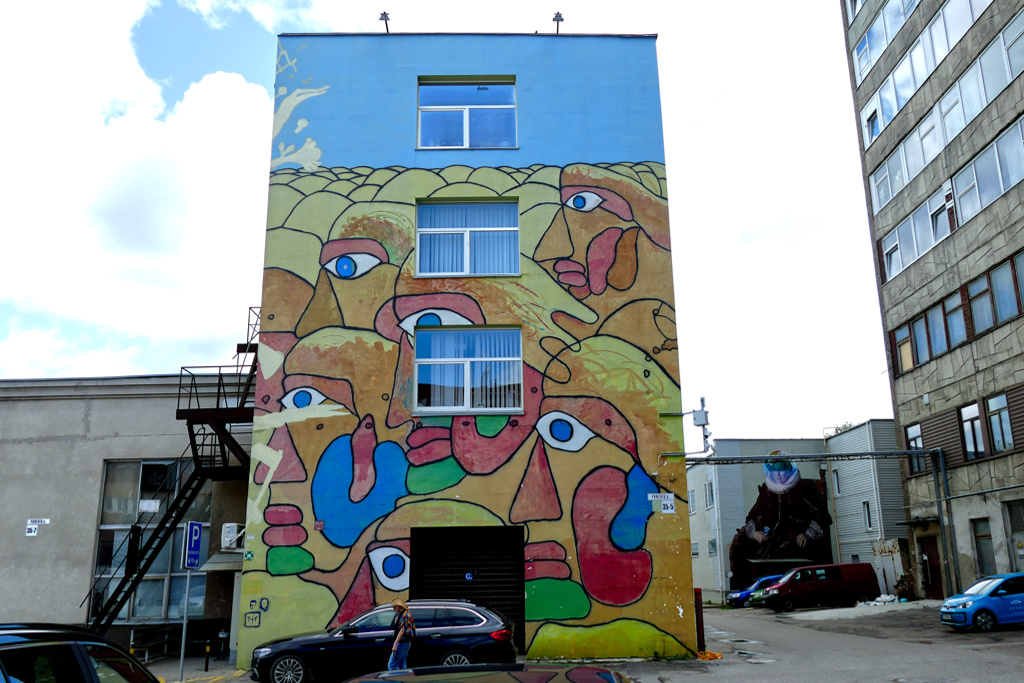
He is known for his improvisational and intuitive approach to visual art. His works combine painting, drawing, and sculpture, often using unconventional materials. He transforms ordinary, discarded materials into complex compositions. Musical motifs frequently appear in his works, which is not surprising, as Ivinskas is also a cellist.
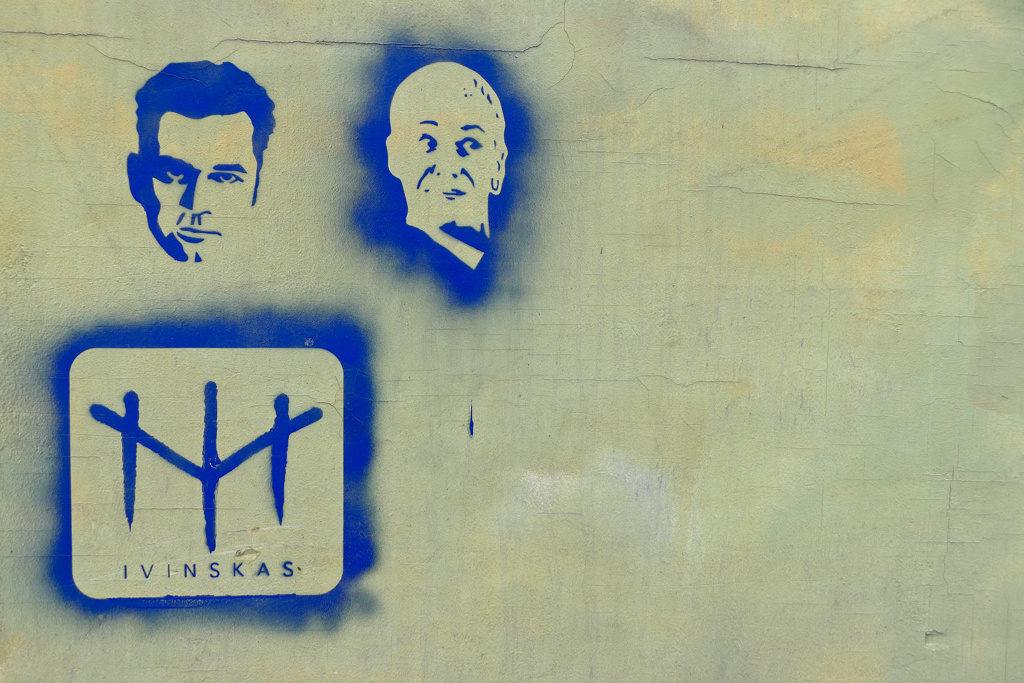
One of his projects was the transformation of Vilnius’s traffic maps into works of art. In 2015, these altered maps were exhibited at the Vilnius City Hall, inspiring viewers to reinterpret familiar everyday objects as creative canvases.
Today, Ivinskas lives between Vilnius and Los Angeles. He has participated in group exhibitions in cities such as New York, Paris, and Los Angeles.
Agnė Stašinskaitė
Agnė Stašinskaitė is a Lithuanian-born visual artist currently living in Portugal. Her artistic activities include illustrations, artworks, and murals.
Her style is characterized by minimalist yet carefully executed line drawings, often created using spray paint or traditional media. These illustrations are visual storytelling, but without strict narrative constraints. They leave space for the viewer to weave their own meanings into the images.

Stašinskaitė’s paintings exude a poetic simplicity and often draw connections between architecture, the environment, and emotions. She has also applied her distinctive line art and minimalist color palette to editorial work and branding projects, demonstrating a versatility rooted in both utility and expressiveness.
Salvija Vaičikonytė
Salvija Vaičikonytė was born in 1995 and lives in Vilnius. She graduated in graphic design from the Vilnius Technology and Design College in 2015. Today, she works as an illustrator, graphic designer, painter, and street artist.
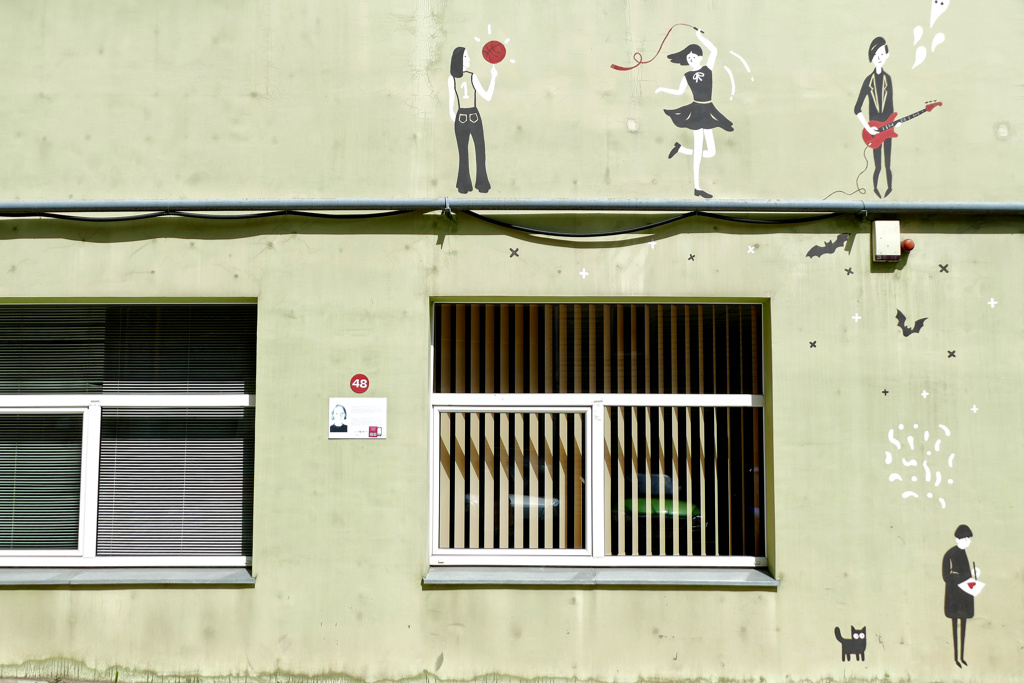
In addition to her visual art, Salvija is also a poet, children’s book illustrator, and winner of regional literary awards.
Algirdas und Remigijus Gataveckas
This mural doesn’t really belong in this section of the post, as it’s not on the grounds of the Atvira Meno Galerija and was created in a different context. However, since it’s right next to the bus stop where you have to get off if you want to visit the open gallery, I’m including it here.
Algirdas and Remigijus Gataveckas are identical twin brothers born in Alytus in 1985. After a difficult childhood, they grew up in an orphanage and discovered breakdancing and street art at an early age. They graduated from the Vilnius Academy of Fine Arts in 2010.
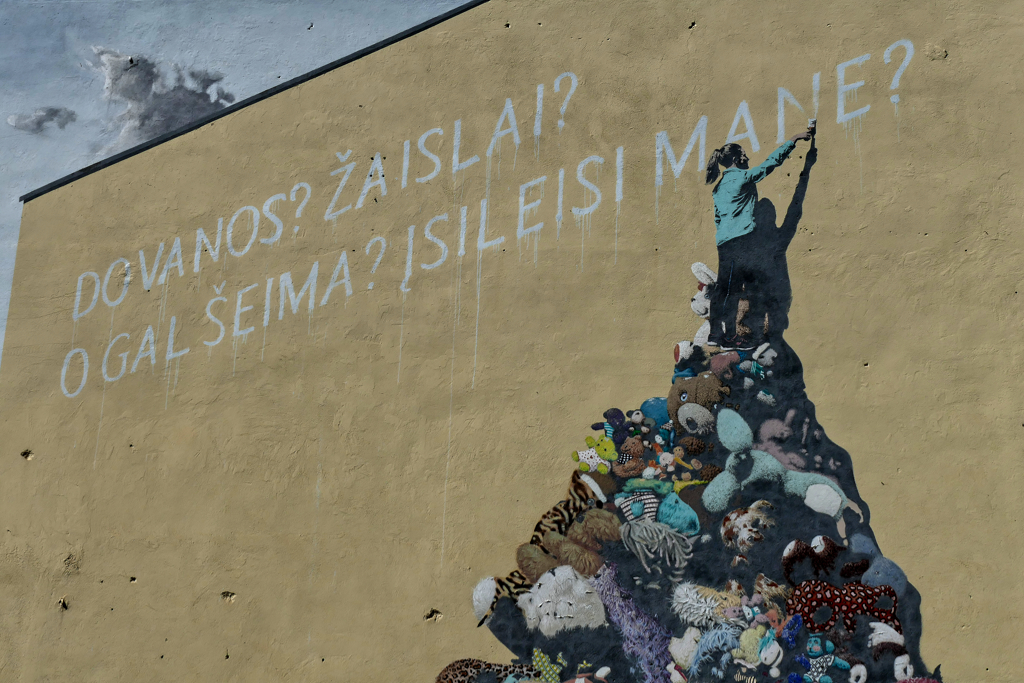
Their work is deeply autobiographical and therefore socially engaged. They create large-scale, hyperrealistic colored pencil drawings that depict intimate human stories with breathtaking detail.
In their series Poveikis, which translates to Impact in English, they portrayed eight former residents of the Alytus orphanage. These portraits not only tell of hardship but also restore agency and self-esteem to underrepresented people. The proceeds were donated to the young people to enable them to begin an independent and dignified life.
In 2012, Algirdas won the Best Emerging Artist award at ArtVilnius for Poveikis.
The works of the Gataveckas are part of the collection of the Lithuanian Museum of Modern Art and are in numerous private collections.
Užupis
After Lithuania’s independence in 1990, artists, creatives, and nonconformists discovered the former run-down neighborhood of Užupis. They began occupying empty houses, setting up studios, and transforming the area into an alternative cultural space.
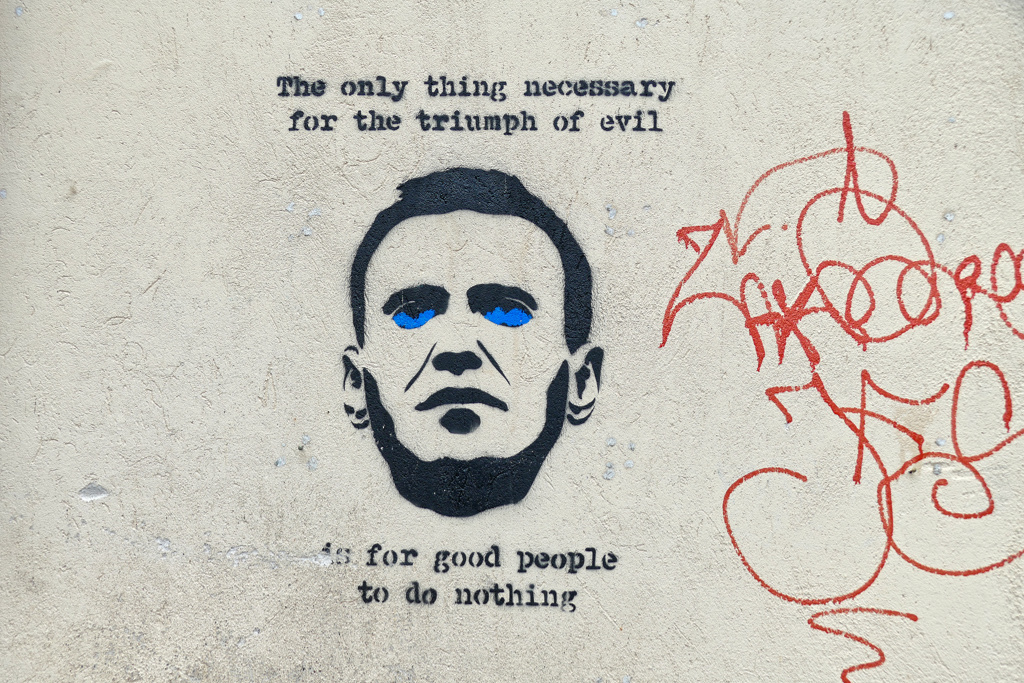
This culminated in the residents symbolically proclaiming the Republic of Užupis on April 1, 1997. It was an ironic and poetic statement for self-determination, artistic freedom, and humanity. Since then, Užupis has had a small border post, a flag, and a president. The constitution of the free republic can be found along Paupio Street. It is displayed on metal plaques in many languages.
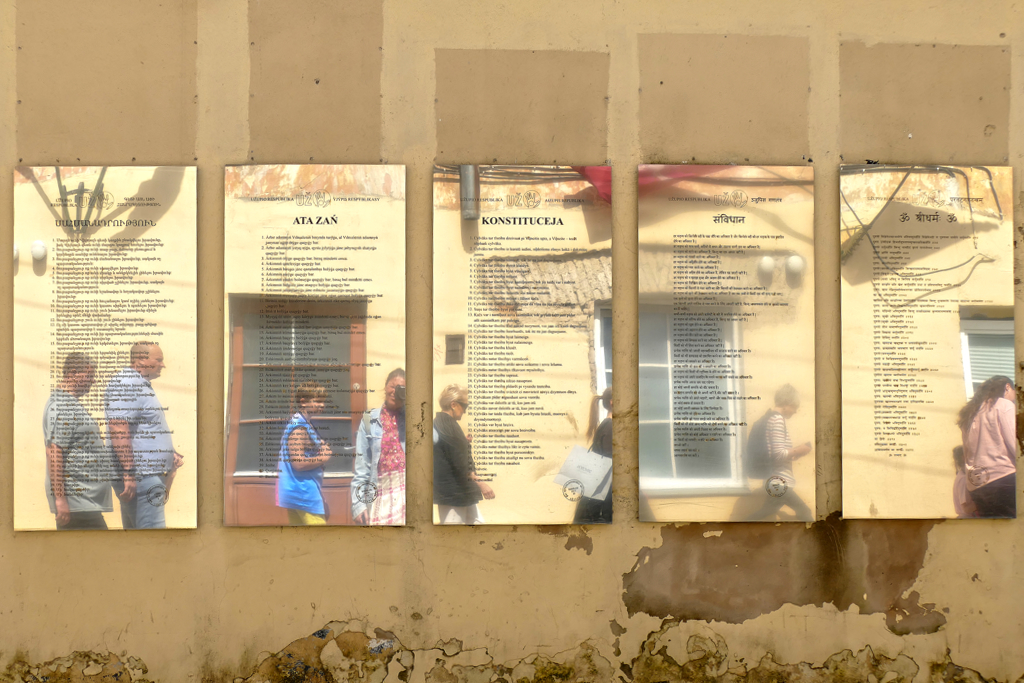
Despite increasing popularity and gentrification, Užupis remains a symbol of freedom, creativity, and cosmopolitanism. Also, apart from the Atvira Meno Galerija, Užupis is Vilnius’ other major creative hub.
Jurga Užkuraitytė
Jurga Užkuraitytė is a muralist whose works subtly connect cultural narratives and public space. One of her most notable urban works honors the renowned Lithuanian writer Jurga Ivanauskaitė, a dedicated advocate for Tibetan freedom. She decorated the octagonal electrical substation with images of Tibetan monks, mountains, birds, and flowers.
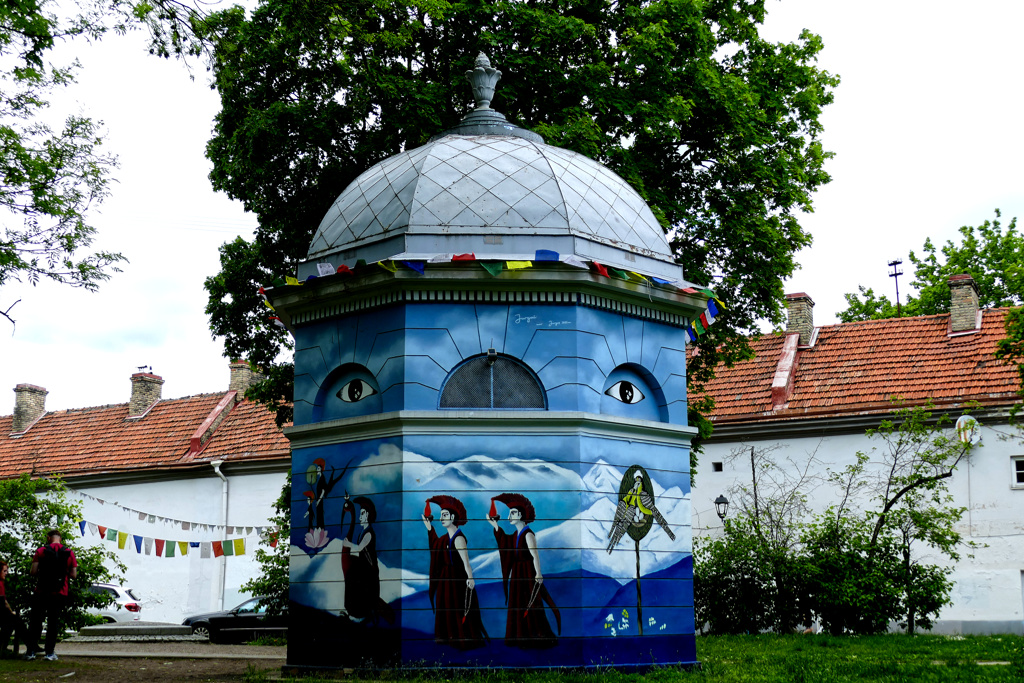
At a site even visited by the Dalai Lama, the mural is now a particularly meaningful landmark within the local community.
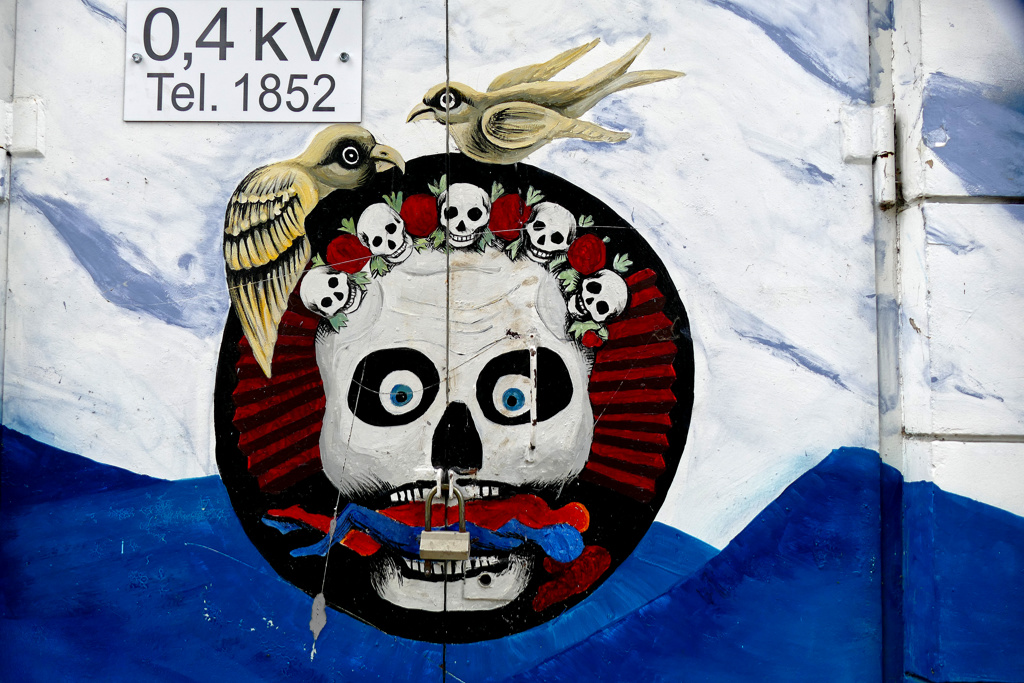
Although it is her most discussed public work, Jurga’s creations are imbued with poetic resonance. She combines literary inspiration and spiritual aspects with public engagement. Thus, she transforms even anonymous infrastructure into sites of cultural reflection, anchoring her street art both allegorically and in personal and collective memory.
Edward von Lõngus
Edward von Lõngus is an Estonian stencil artist who is often compared to Banksy because of his style, socio-political themes, and enigmatic identity.
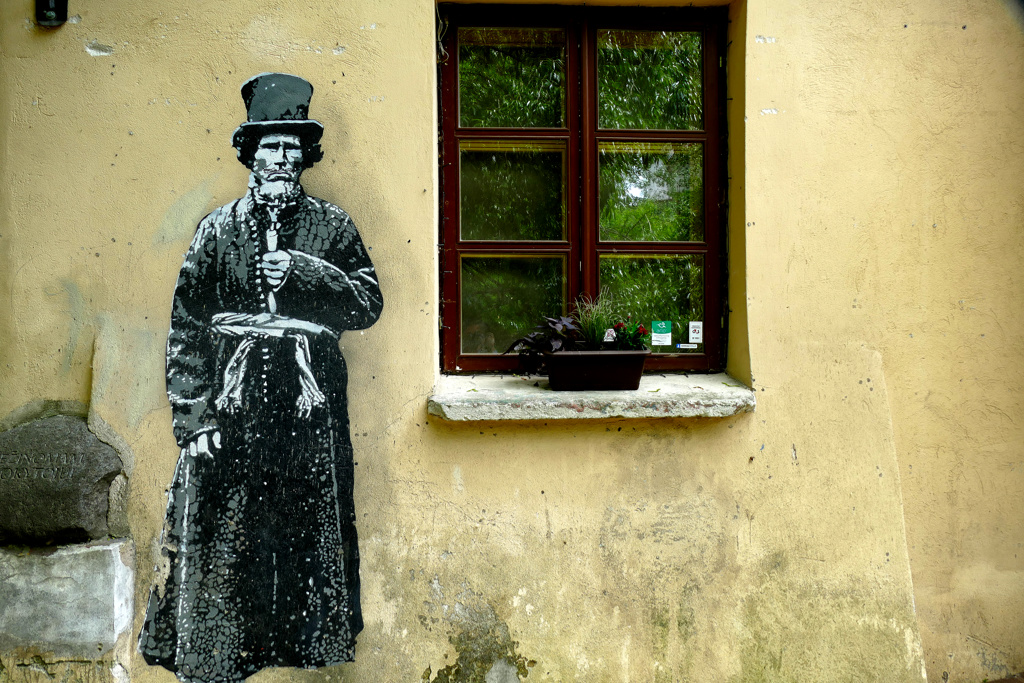
As part of his digital street art project (R)estart Reality, which took place as part of the Estonian Presidency of the European Union and the cultural program for the celebration of the 100th anniversary of the Republic of Estonia, he painted in Berlin, Brussels, Budapest, Copenhagen, Helsinki, London, Paris, Riga, Rome, Vienna, and Vilnius motifs that are closely linked to Estonian culture and history. Each character then tells something about Estonian traditions via an augmented reality app.
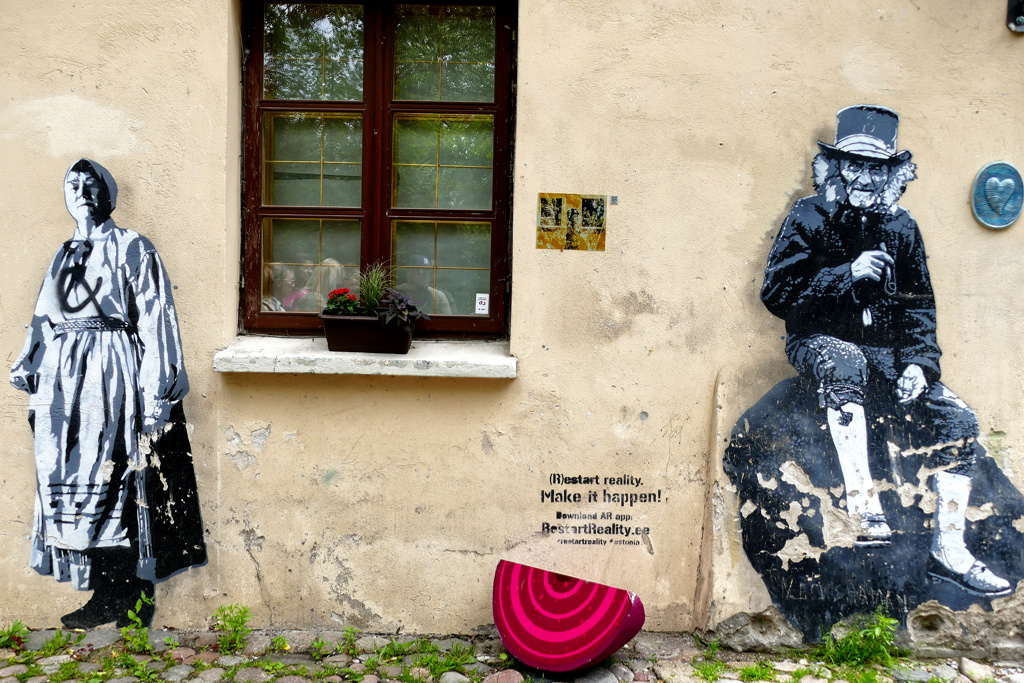
The Estonian Ministry of Foreign Affairs awarded Edward von Lõngus the 2018 Culture Prize for this work.
I’ve already introduced Edward von Lõngus’s art project in my posts RIGA – a guide to Latvia’s entrancing capital, as well as Best Street Art in BRUSSELS.
Martynas Šnioka
Martynas Šnioka aka Shnioka is a street artist, illustrator, and tattooist based in Vilnius. He is recognized for his bold, graphic murals that fuse human and animal forms in vibrant, nature-inspired compositions.
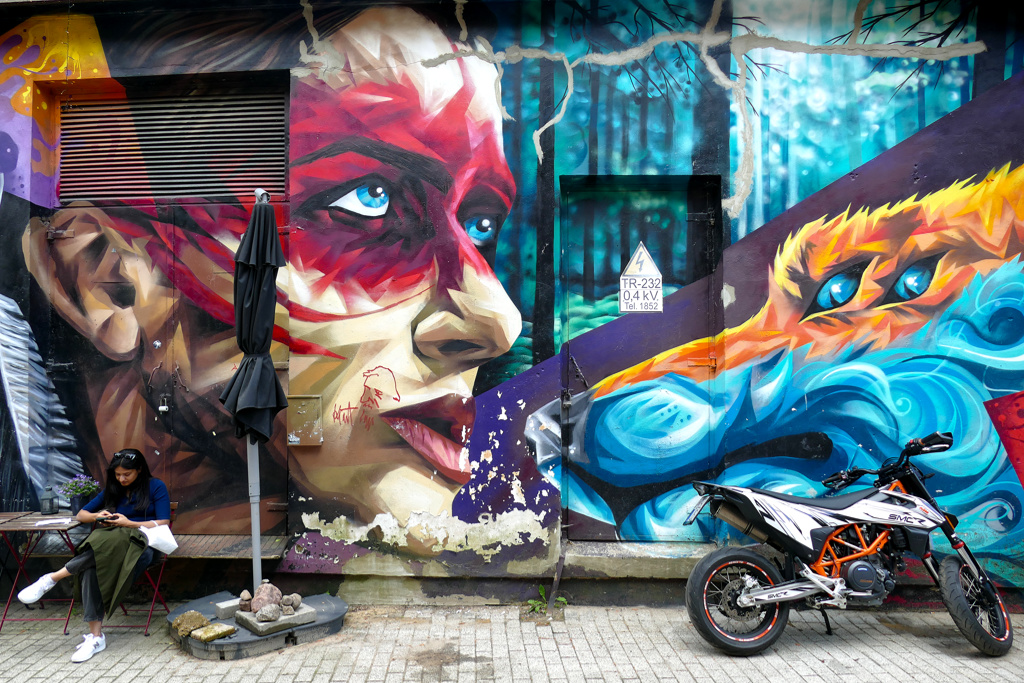
Shnioka’s work often depicts hybrid faces, emphasizing the connection between humanity and the natural world. He uses strong outlines, bright color palettes, and seamless blends of abstraction and realism to create visually striking, animalistic-human portraits that feel both bold and harmonious.
Active across Vilnius and Kaunas, his murals decorate walls, electrical substations, and under-bridge structures.
Beyond murals, Martynas is an accomplished tattoo artist.
Paparazzi
Achilleas Michaelides aka Paparazzi was born in 1982 in the Georgian capital of Tbilisi. Inspired by the graffiti and hip-hop culture of Thessaloniki, he moved to Cyprus in 2002. There, he revolutionized the local art scene by transforming neglected walls and urban corners into lively canvases.
In his work, Paparazzi combines classical artistic techniques with street art. His murals often depict hyperrealistic human faces and socially relevant themes.
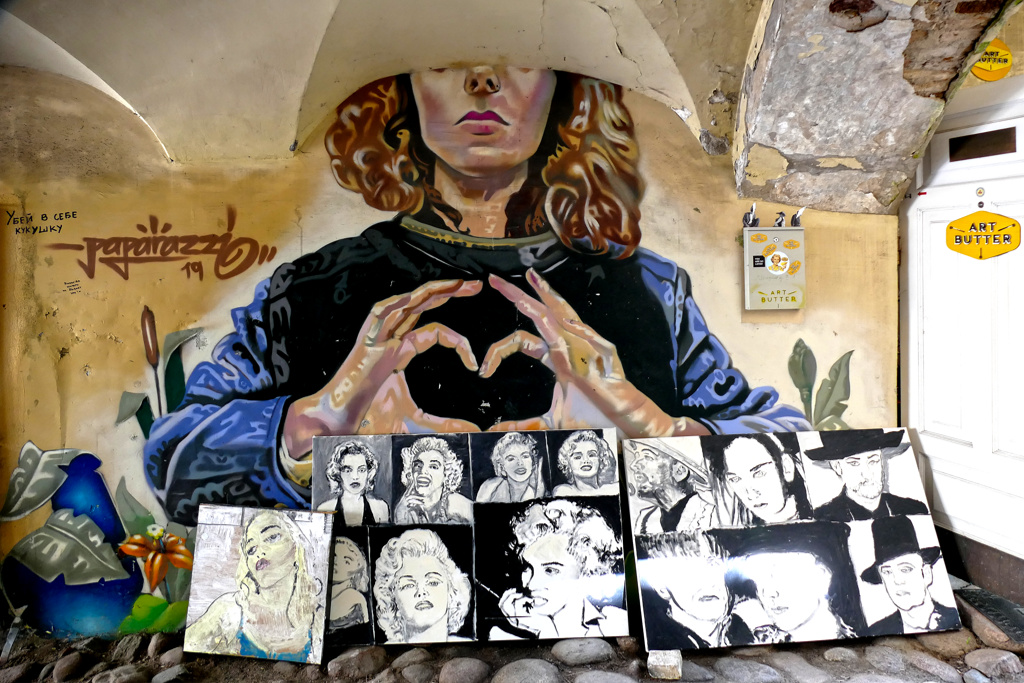
In addition to walls, Paparazzi has also presented his works in galleries.
He is also deeply committed to community building and cohesion. He founded the Ayia Napa Street Art Festival, curated group exhibitions in Cyprus, and collaborated with fellow artists to bring color and dialogue into public spaces.
Paparazzi values legality and social value. For this reason, he works with municipalities and property owners, emphasizing that street art can foster community, stimulate thought, and bring art closer to people who don’t often visit museums or galleries.
Paparazzi’s works can be seen not only in Vilnius, but also in Kaunas and in Mikėnai, a small Lithuanian village where the grandmother of the artist’s wife’s lives.
Žygimantas Vilkas Amelynas
Žygimantas Vilkas Amelynas was born and raised in Kaunas, where he lives and works to this date. He is a graphic designer and street artist. His murals capture a poetic interplay between narrative imagery and urban space.
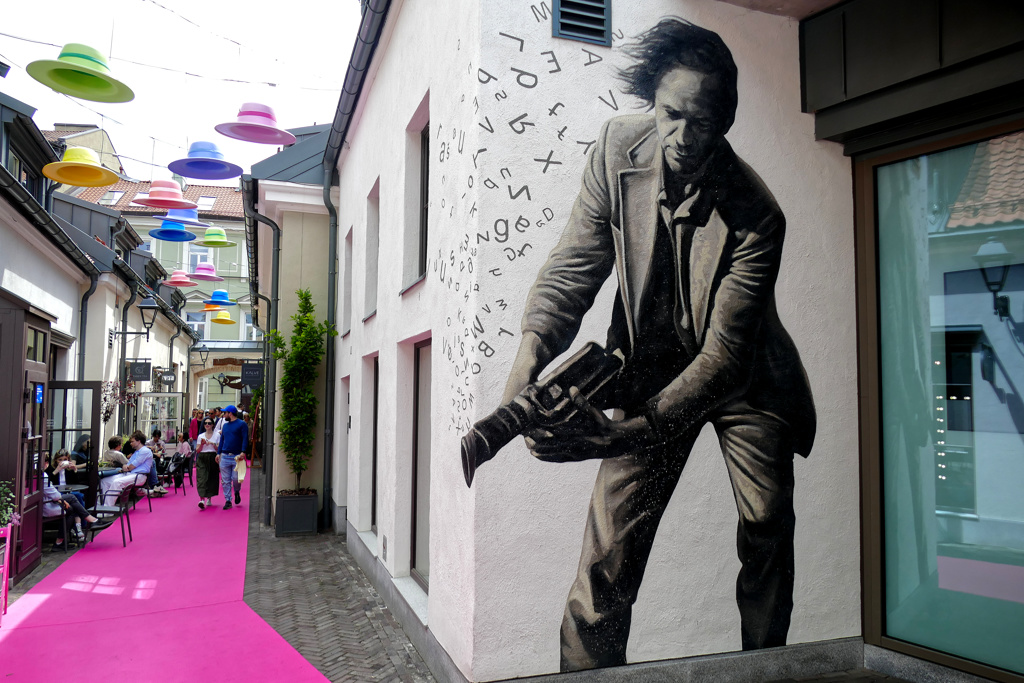
Throughout his works, Žygimantas Amelynas demonstrates a consistent interest in revitalizing public areas with figurative storytelling that balances visual beauty, local heritage, and architectural context.
There’s More
As I pointed out, street art is rather concentrated in certain areas. However, you’ll find individual pieces here and there, and since some of them are really significant for the international urban art scene, I’m briefly introducing them below.
Lina Šlipavičiūtė
Lina Šlipavičiūtė‑Černiauskienė is a versatile Lithuanian artist whose work oscillates between monumental art, urban art, and socially engaged art. Born into a family of artists, she studied fresco and mosaic art at the Vilnius Academy of Fine Arts. Today, she combines her roots in traditional monumental art with contemporary forms of expression such as street art, installations, comics, and mixed-media collages.
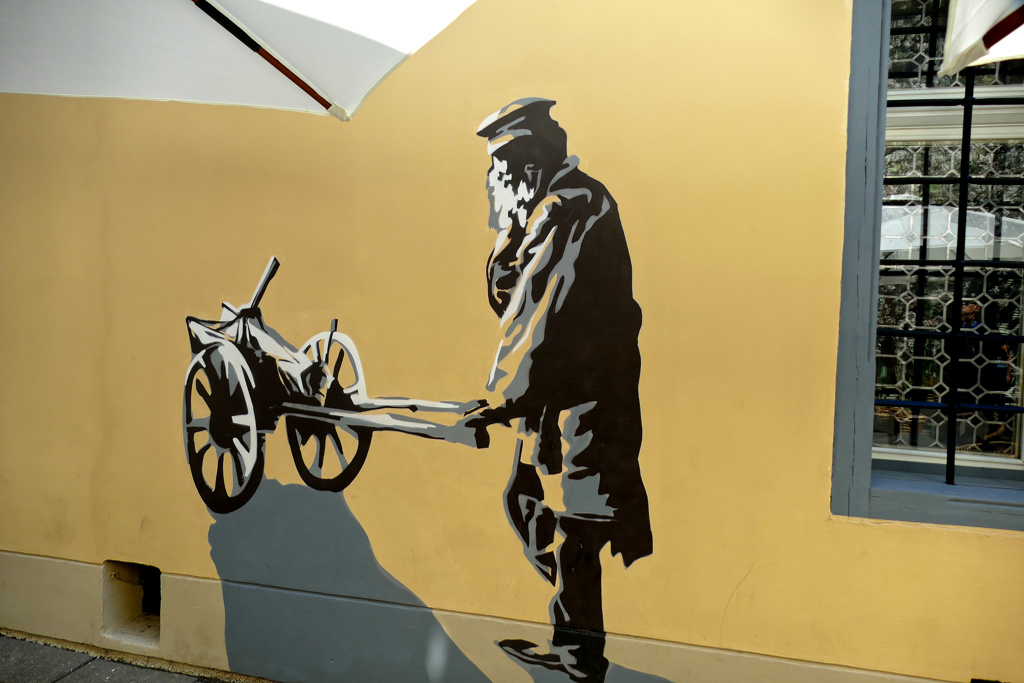
She became particularly famous for her urban memory project Sienos prisimena, hence, Walls That Remember, in which she used stencil techniques to apply historical photographic scenes from the everyday life of Vilnius’ Jewish community to house facades in the former Jewish quarter. Her goal is to challenge collective memory and make visible what has been erased or forgotten.
Her consistent stance is that art should not merely decorate, but should also provoke, question, and connect. In her projects, formal rigor and technical precision meet emotional depth and social relevance. Her art is not loud, but haunting.
The art project Sienos prisimena aims to make the life of the once-thriving community in the historic Jewish Quarter visible and tangible. To this end, authentic photographs from the interwar period are being used to create stencil neo-frescoes, which will be installed in the former Jewish Quarter.
A special feature is its interactivity. QR codes next to the images allow passersby to discover historical originals, making-of images, and a location map. This turns virtual memories into real ones. Originally launched in Vilnius, the project has since expanded to other Lithuanian cities.
Zoe Sever
To mark the 700th anniversary of Vilnius and the 30th anniversary of diplomatic relations between Israel and Lithuania, the capital received another mural. It was painted by Zoe Sever, who was born in 1974 in the Ukrainian city of Lviv and now lives in Israel. She studied graphic design as a teenager in Lviv and later studied architecture at the Bezalel Academy in Jerusalem.
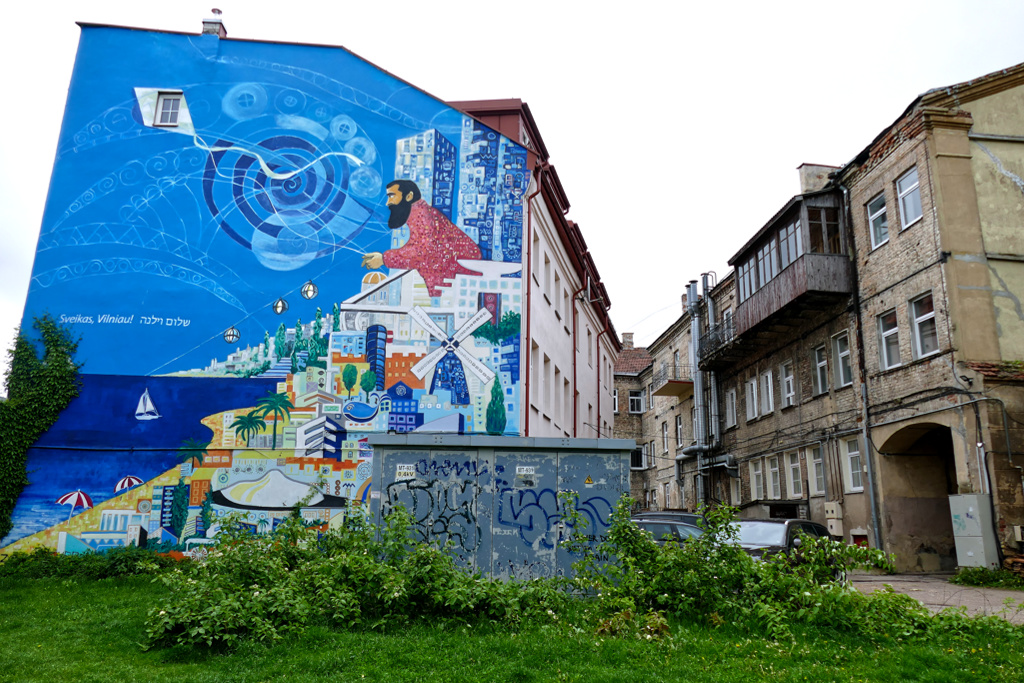
In these times, it is a double-edged sword to name a picture after a quote by Theodor Herzl.
Her colorful works are an engaging blend of naiveté and a modern approach to architecture.
Cities and buildings are often the main motifs, while figures appear less frequently and landscapes dominate.
Millo
Francesco Camillo Giogino aka Millo was born in Italy in 1979. He studied architecture and never intended to become an artist. However, painting fascinated and appealed to him so much during his studies that he persisted. He is now decorating high-rise façades with murals in monochrome black and white lines. Sometimes he adds a splash of color to give his creatures a more vibrant appearance.
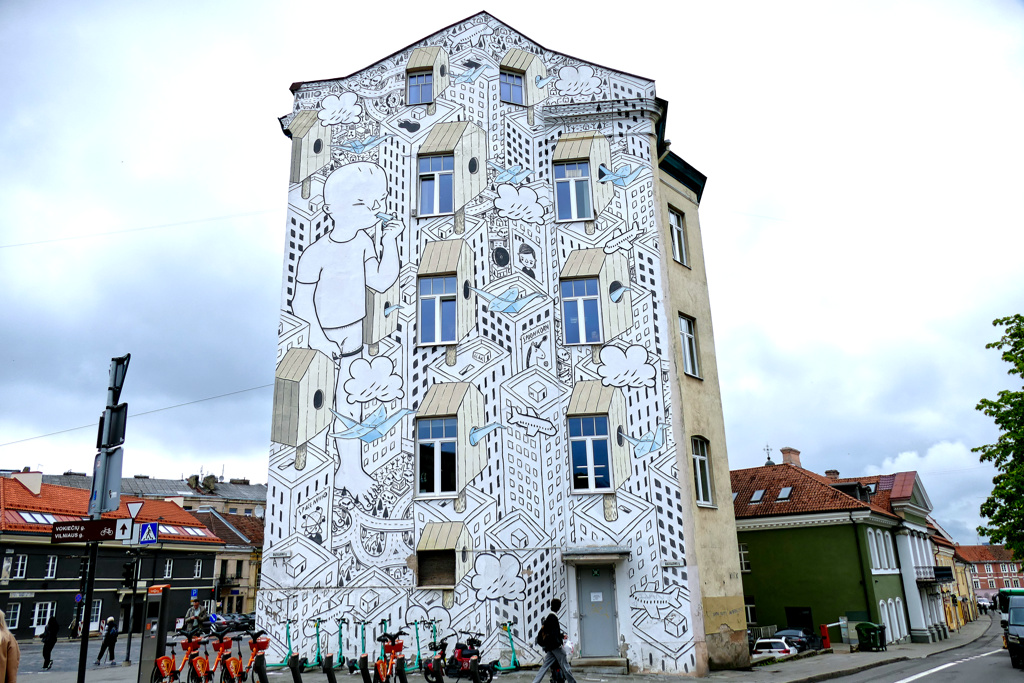
His innocent and childlike giants are often depicted in playful situations amidst cityscapes. His approach to having many of these creatures interact with the surrounding architecture stems from his time as an architecture student.
With his works, Millo strives to portray the purest side of humanity: joy and play.
I’ve introduced another one of Millo’s murals in my post Best Street Art in BERLIN.
Os Gêmeos
Otávio and Gustavo Pandolfo were born in São Paulo in 1974 and call themselves Os Gêmeos, hence, The Twins in Portuguese. Their artistic career began in the late 1980s, initially influenced by hip-hop culture. Later, elements of Brazilian folklore and indigenous traditions flowed into their work. Their distinctive style is characterized by yellow-skinned characters in surreal environments. These figures are inspired by their shared dreams and experiences.
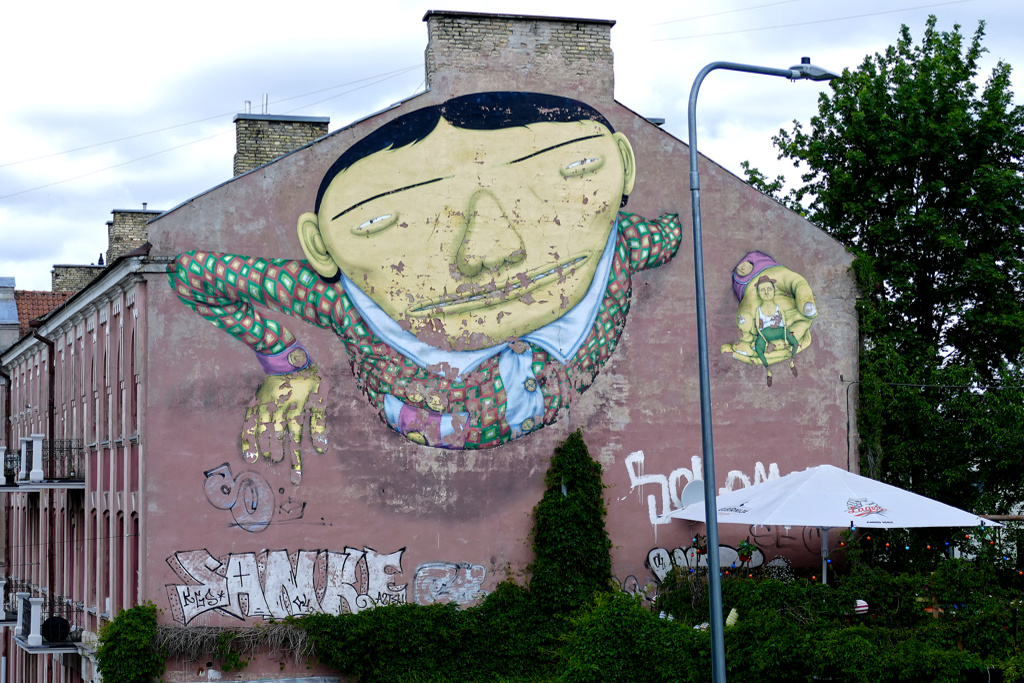
Os Gêmeos have collaborated with renowned artists and have been represented in major exhibitions worldwide, including at the Tate Modern in London and the Museum of Contemporary Art in Los Angeles.
For other great murals by the famous street art twins, see my post about São Paulo, as well as Best Things to Do on a Long Weekend in Milan.
Etto Ja
Artur Širin, aka Etto Ja, is a Ukrainian-born Lithuanian illustrator, architect, and street artist. He is known for his dynamic murals, which often feature bold lines, bright colors, and complex patterns.
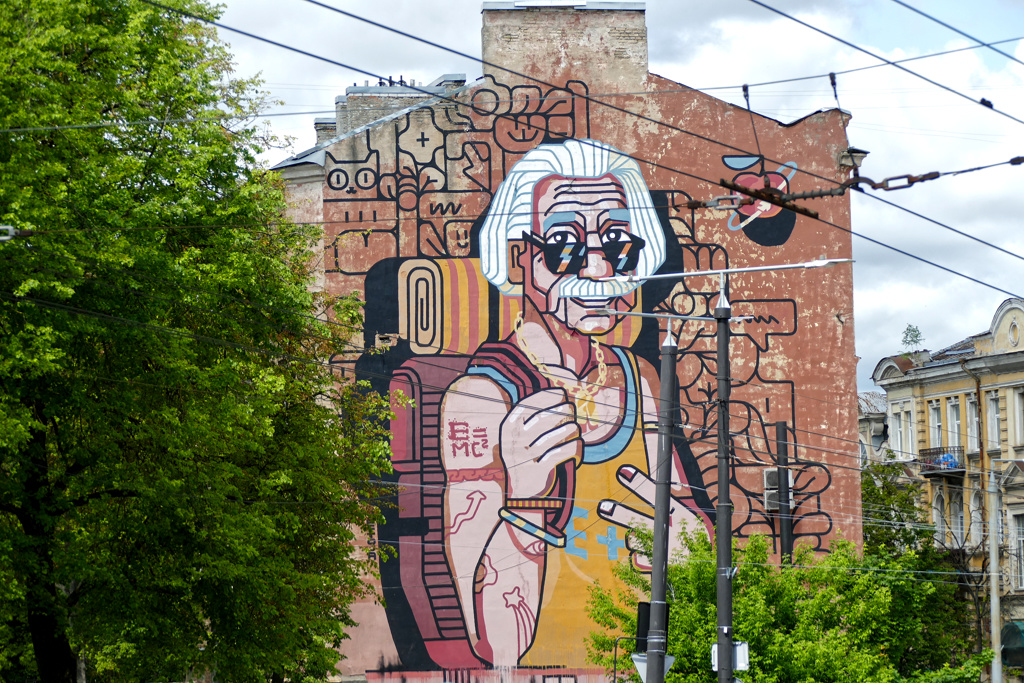
This 20-meter-tall mural portrays a youthful, adventurous Albert Einstein, symbolizing the endless possibilities for learning and discovery.
In addition to his murals, Etto Ja has collaborated on various projects, including illustrations for the Erasmus+ program and the design of brands such as Vytautas mineral water. His artistic career reflects his commitment to using public art as a medium for social commentary, cultural expression, and civic engagement.
Jurgis Tarabilda
Jurgis Tarabilda was born in Vilnius in 1992. He graduated from the Vilnius Academy of Arts in 2015 with a degree in sculpture. In his art, Tarabilda plays with concepts of flatness, fluidity, and lightness, transforming painterly or digital aesthetics into tangible, multi-layered experiences using color, objects, video, and light.
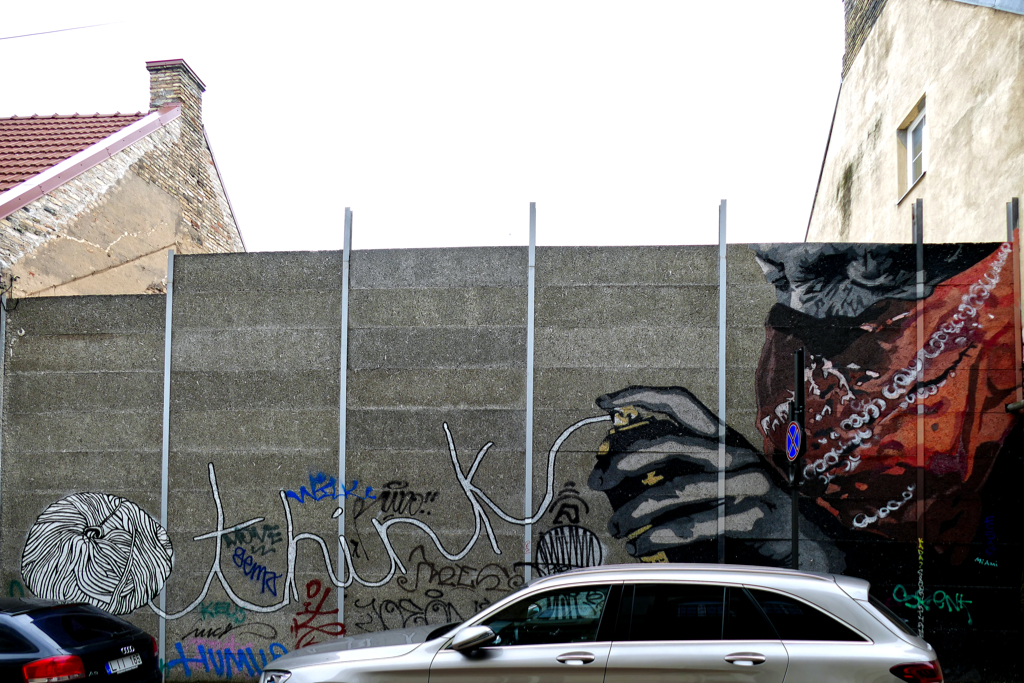
Tarabilda is a multidisciplinary innovator. Whether immersive installations, abstract murals, or studio experiments, his art always invites intuitive interpretation and playful exploration.
He has held several solo exhibitions and represented Lithuania at international art fairs such as Positions Berlin and VOLTA Basel. His works are part of the Lithuanian MO Museum and are held by numerous private collectors in Europe and North America.
In 2017, he won the Audience Award at the Young Painter Prize and was named Audience Artist of Art Vilnius 2020.
Žygimantas Amelynas
Žygimantas Amelynas was born in 1988 and lives in Kaunas. He is best known for his large-scale public murals and as co-founder of the creative collective Gyva Grafika. Amelynas has become a leading figure in the Lithuanian street art scene, transforming urban spaces into socially engaged environments.

One of his most significant projects is the mural Protect the Future, commissioned by NATO in Vilnius. Created in January 2024 to commemorate the 75th anniversary of NATO and the Vilnius Summit, the mural represents a milestone as NATO’s first official street art initiative.
The mural is located on a wall adjacent to the lush Reformatų Park. Under a bright blue protective umbrella bearing the NATO logo, people peacefully go about their daily activities. This metaphor for protection and peace conveys a simple yet powerful message: freedom is only possible in safety.
With his mural, Amelynas wants to show how beautiful and important it is to live without fear, to come together with loved ones, and to dream of a safe future.
Do Pemerogi – Until Freedom
For the longest time, Russia and later the Soviet Union dominated and oppressed the Baltic States. Therefore, it comes as no surprise that after the war in Ukraine, a shockwave swept through these nations, and even after three years of ongoing war, solidarity is expressed on a whole different level than in most other countries.
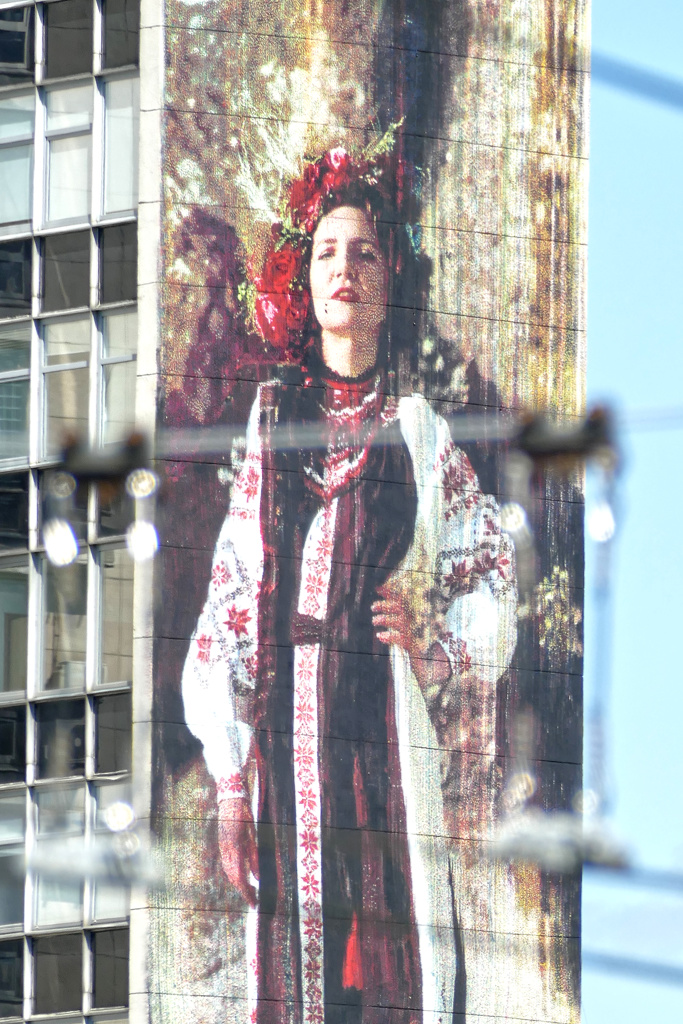
For example, the art project Do Peremogi, which translates to Until Victory. It was developed by Lina Šlipavičiūtė, whom I’ve already introduced above, and emphasizes solidarity with Ukraine. The mural was created by a team of Lithuanian, Ukrainian, and Estonian artists. The first one depicted Tetiana Drobotia, a Ukrainian volunteer from Zaporizhia, photographed by Olena Tytarenko. The mural, measuring over 200 square meters, was then spray-painted by a robot named Albert, developed by Estonian artist and engineer Mihkel Joala. Albert is the only robot in the world designed to perform large-scale street art.
The project was financed through a public fundraising campaign that raised 13,000 €uros within a few days.
Currently, the mural Nezlamna, which translates to unbreakable, can be seen from the opposite bank of the Neris River.
On Instagram
To dig deeper into the subject and see more of the amazing art the above-featured artists have created, you can just check out their Instagram accounts:
Žygimantas Amelynas
BLO
Dirty Elmo
Etto Ja
Algirdas Gataveckas
Remigijus Gataveckas
IUSTAS
Martynas Ivinskas
Agnė Juršytė
K ART 7
Povilas Kupčinskas
David Leitner
Millo
Morfai
Eglė Narbutaitė
Os Gêmeos
Paparazzi
Perkup
Zoe Sever
Lina Šlipavičiūtė
Martynas Šnioka
Sokar Uno
Agnė Stašinskaitė
Jurgis Tarabilda
Telmo Miel
Marija Tiurina
Jurga Užkuraitytė
Salvija Vaičikonytė
Žygimantas Vilkas Amelynas
Edward von Lõngus
Ernest Zacharevic
Eglė Žvirblytė
no account known
no account known
no account known
How to Get Around
Vilnius’ Old Town is easy to explore on foot. Since some of the main sights are located in hilly areas and many streets are cobblestoned, I can’t really recommend exploring the city by bike. Nevertheless, it is an option.
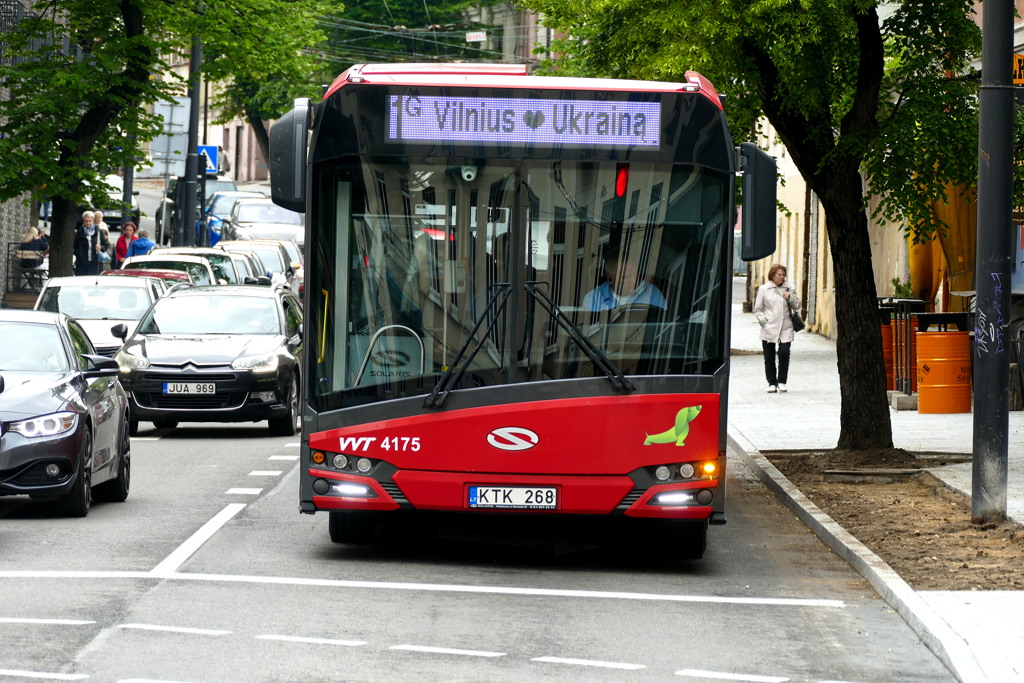
Like virtually all European cities, Vilnius has a well-developed public transportation system, consisting primarily of buses and trolleybuses. The network is comprehensive and, above all, very affordable. Interestingly, it is supplemented by privately operated minibuses, which are integrated into the official system. These minibuses are faster than regular buses and have fewer stops. Regular bus service runs from 5:30 a.m. to midnight. After that, night buses run throughout the night with a limited schedule.
A single ticket costs 0.65 €uros in an app, whereas a paper ticket costs 0.90 €uros. For 5 €uros, you can get a 24-hour day ticket, and a 3-day ticket costs only 8 €uros. Note that apparently, the app works only with Lithuanian phone numbers, and everything is in Lithuanian. Therefore, I’d argue that the best way to buy tickets is by getting the Vilniečio Card. There are ticket machines at some stops, and paper tickets are also available on the bus. Keep in mind that you cannot pay in cash but need to use a contactless means of payment.
Map
This map should help you find the murals I’m introducing in this post. Obviously, all works listed in the section Atvira Meno Galerija are located exactly there, so I didn’t bother to mark them all.
Clicking on the slider symbol at the top left or the full-screen icon at the top right will display the whole map, including the legend.
Looking for urban art was only one of the awesome things I got to do during my visit to mesmerizing Vilnius. In my post What to See on an Unforgettable Weekend in VILNIUS, I take you on a comprehensive city tour.
Pinnable Pictures
If you choose to pin this post for later, please use one of these pictures:
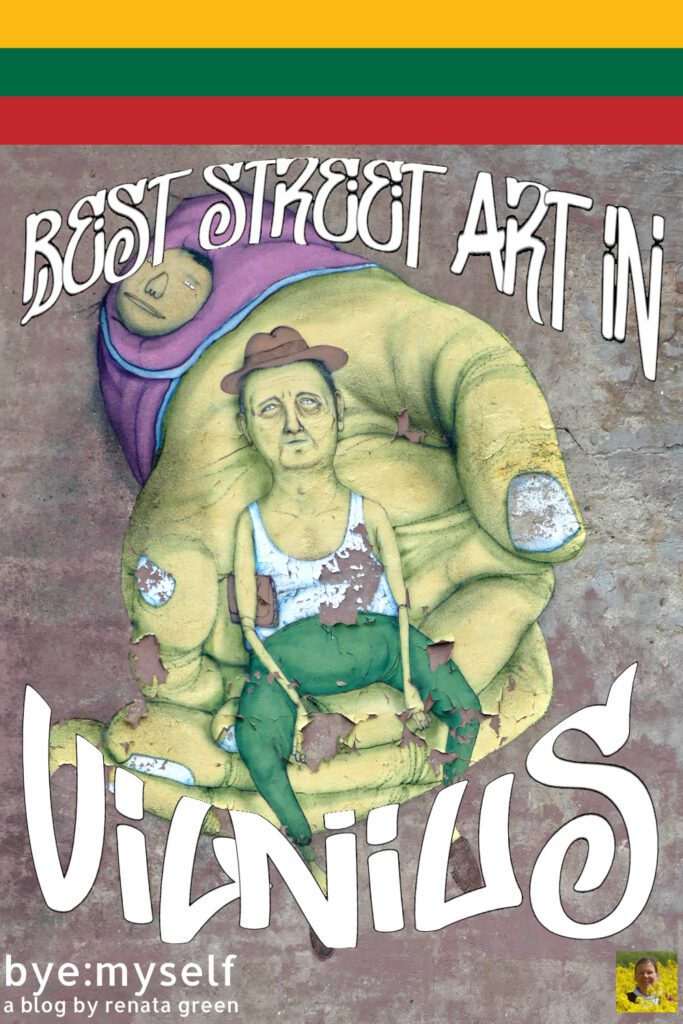
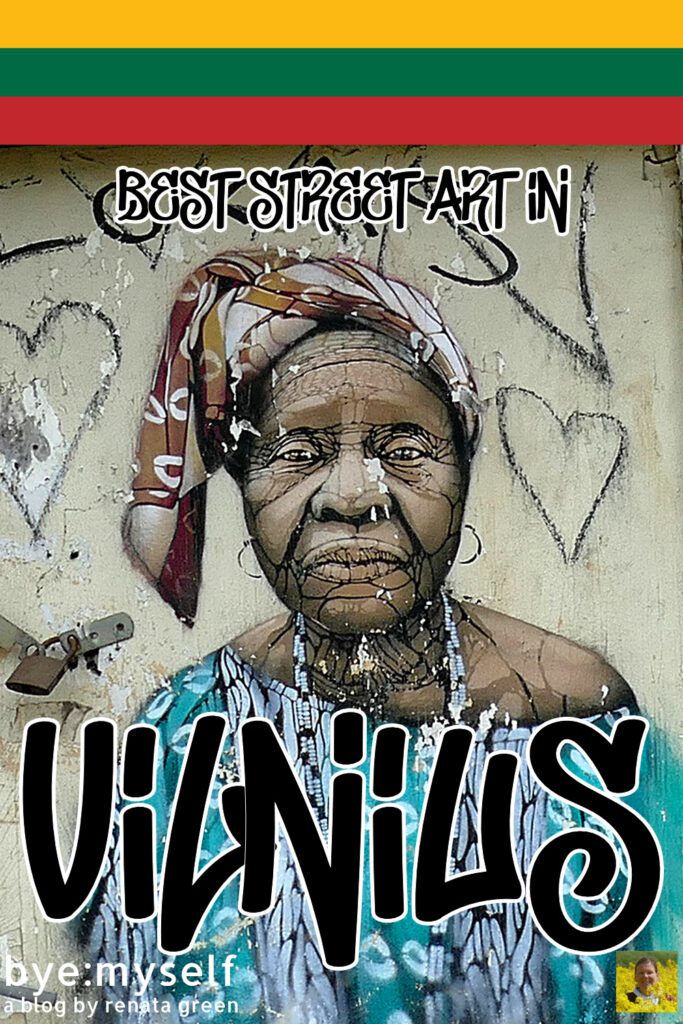
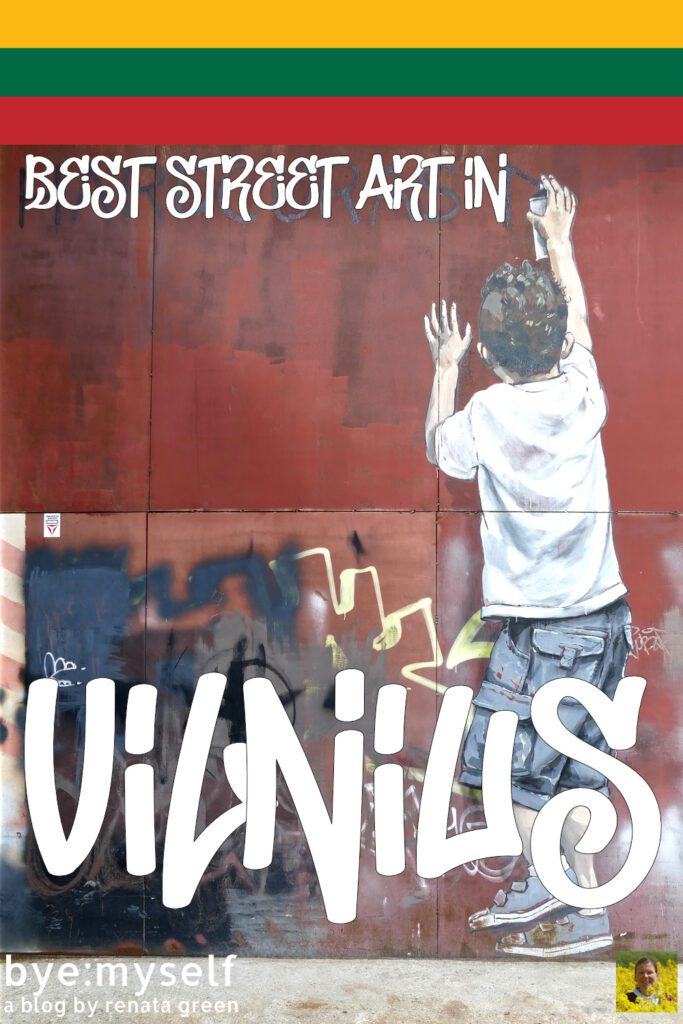
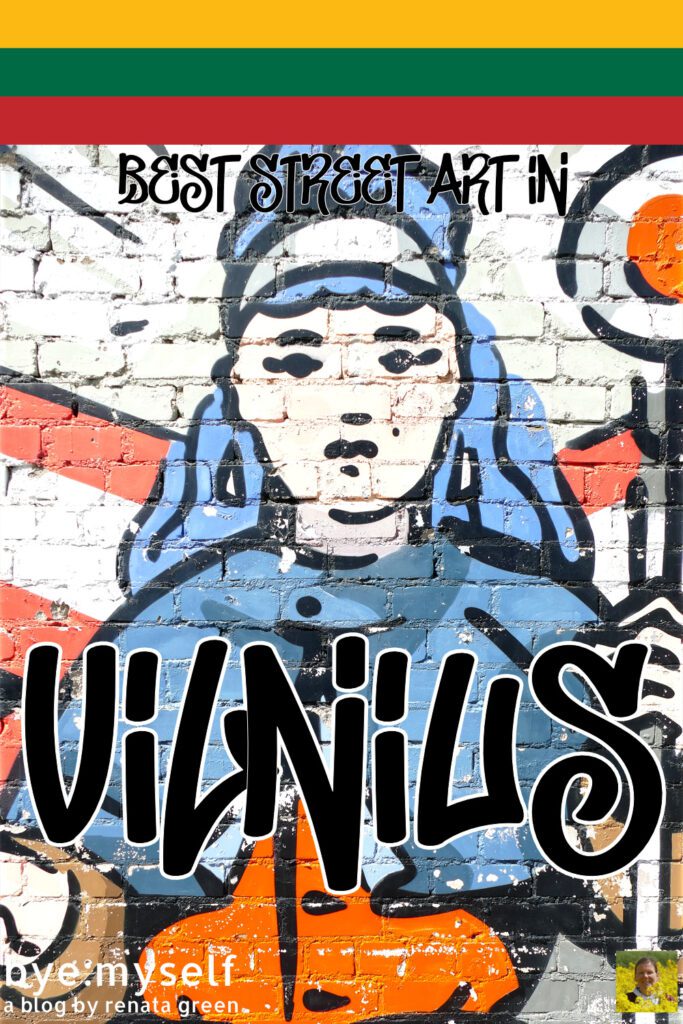
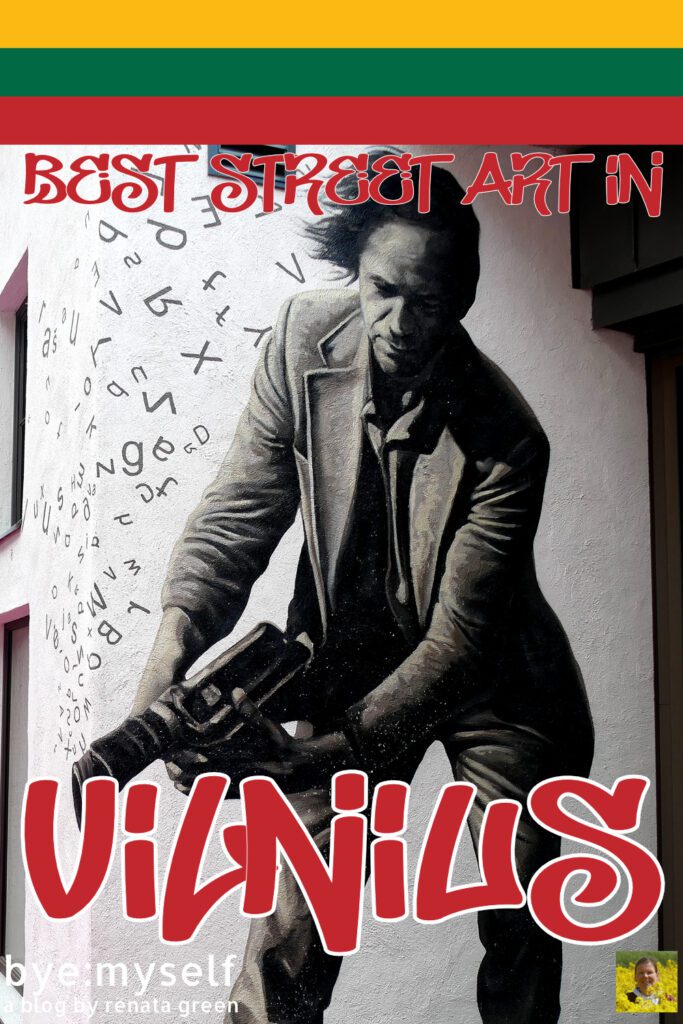
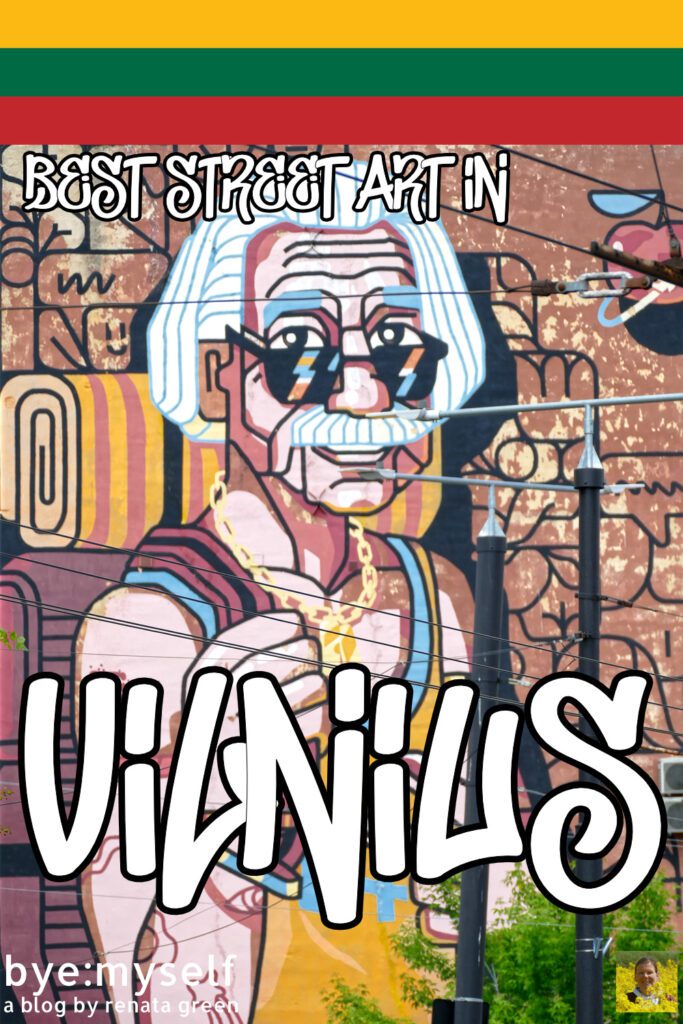
Did You Enjoy This Post? Then You Might also like these:
BORDEAUX: Best Street Art on the Right Bank of the Garonne
Guide to CALI – And a Day Trip to Paradisiac Haciendas
The Amazing Murals of the Hotel Ruins of Alyko
What to See in BIRMINGHAM: A Peek Behind the Blinds of Britain’s Second-Largest City
One Week in BONAIRE: The Best Activities Beyond Diving
Best Street Art in HAMBURG
Best Street Art in LISBON – Part III: Moscavide
ARUBA: The Powerful Murals of San Nicolas
* This is an affiliate link. If you book through this page, not only do you get the best deal. I also get a small commission that helps me run this blog. Thank you so much for supporting me!
